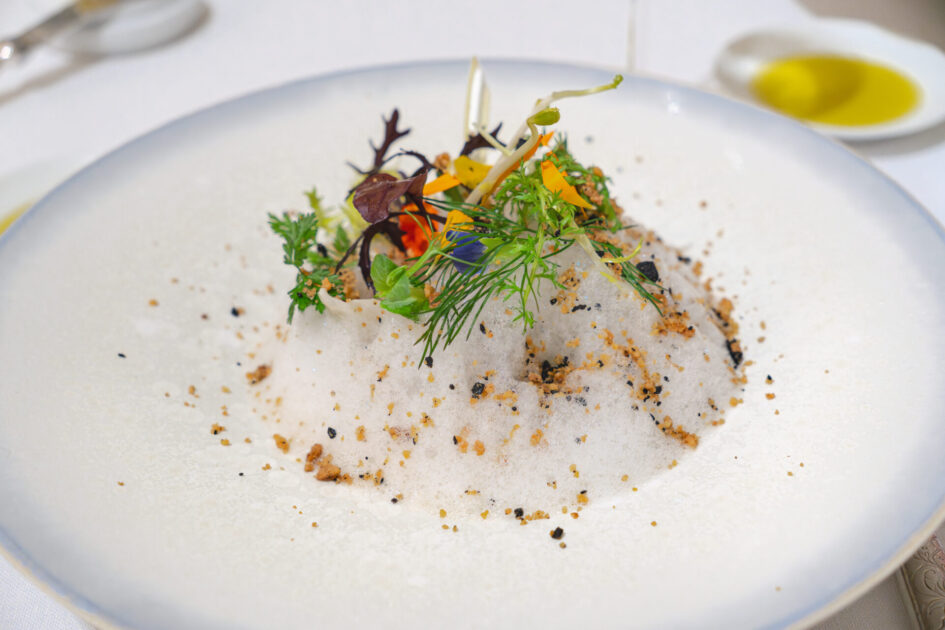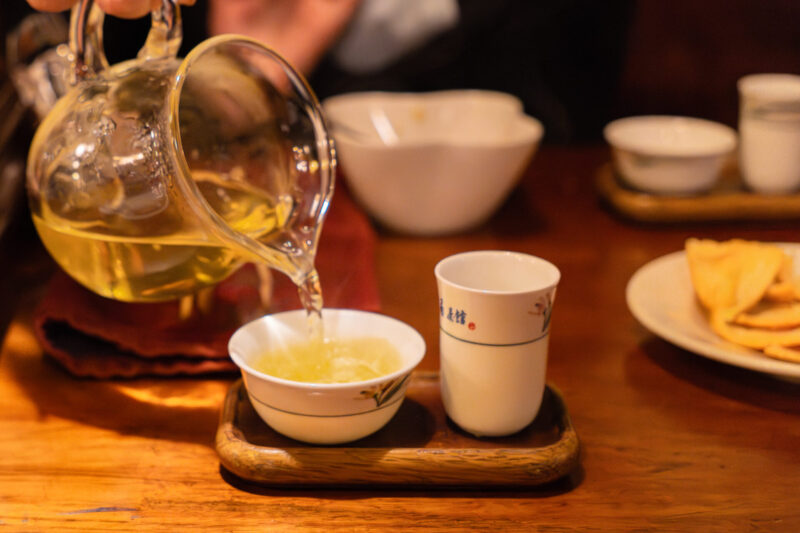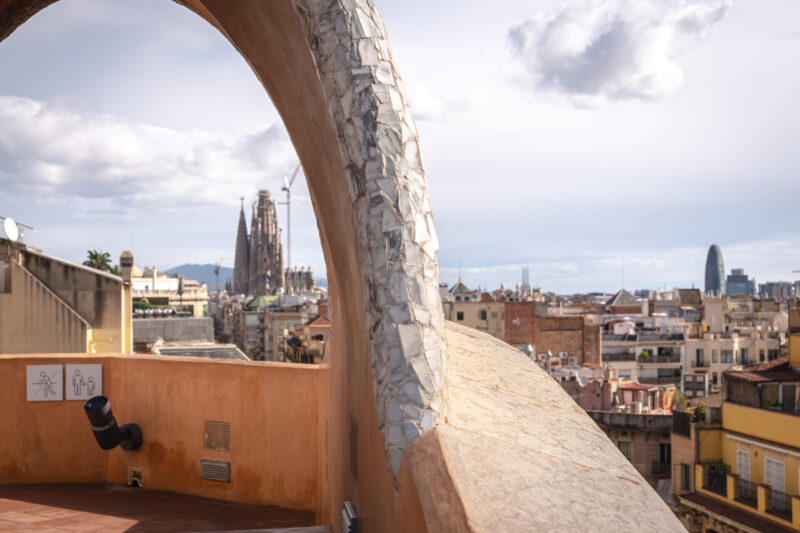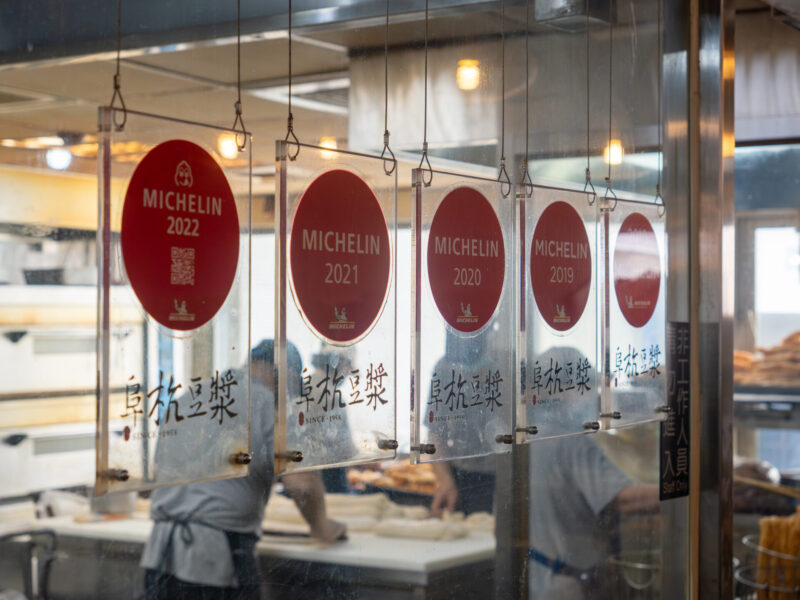CONTENTS
About Restaurant KEI
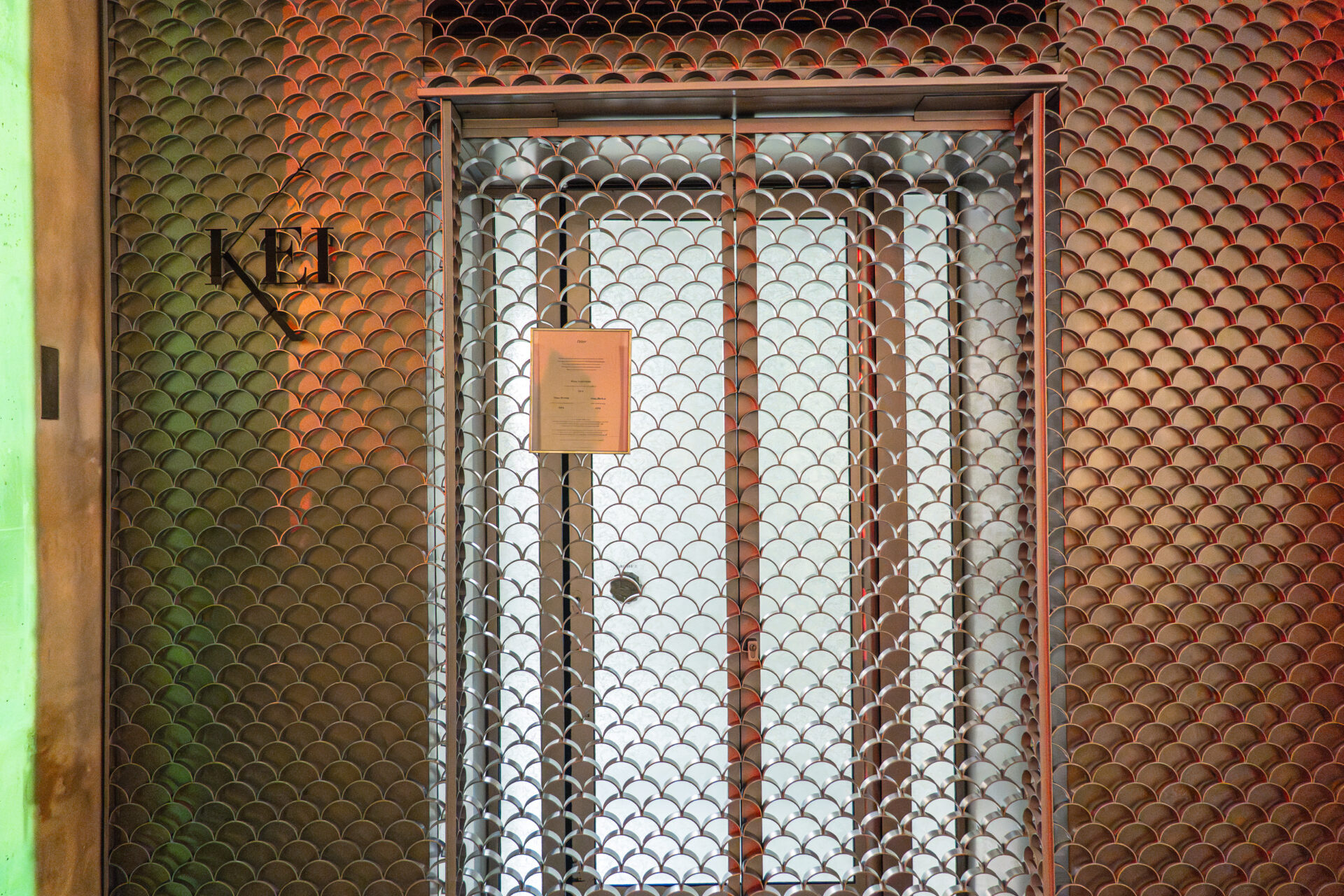
Concept
“The French Cuisine That Transcends French Cuisine”
KEI’s concept is a one-of-a-kind gastronomy that merges the techniques of classic French cuisine with the sensibility and delicacy unique to the Japanese. While showing deep respect for the traditions of French cooking, it is characterized by a free-spirited creativity unconstrained by convention and a composition that pursues the essence of each ingredient.
Among its many qualities, what stands out most is the commitment to “lightness.”
While retaining the richness inherent in French cuisine, KEI strips away excess heaviness and fat, elevating each dish into something simple yet refined.
Furthermore, KEI values not only the food, but the entire experience as a “lasting memory”—including the space, service, and flow of time. The spirit of Japanese culture—such as kacho-fugetsu (the beauty of nature) and wabi-sabi (austere refinement)—is reflected throughout every aspect.
Chef Kei Kobayashi
The first Japanese chef to receive three Michelin stars, Kei Kobayashi has refined his aesthetic and technical sensibilities to an exceptional level.
Born in 1977 in Nagano Prefecture, Kobayashi grew up watching his father, a traditional Japanese chef, and became naturally familiar with cooking from an early age. In his teenage years, he began his culinary journey, and upon encountering the cuisine of Alain Chapel on television, he was deeply moved—deciding then to devote himself to the world of French gastronomy.
After moving to France, he trained at numerous prestigious restaurants. Among them, he studied under giants such as Alain Ducasse, Gilles Goujon, and Alain Senderens, mastering the techniques and spirit of classic French cuisine. At the same time, he nurtured a delicate and precise sensibility as a Japanese chef, never losing his sense of harmony and restraint.
In 2011, he opened his own restaurant, “Restaurant KEI,” in the 1st arrondissement of Paris.
Recognition

“Restaurant KEI,” led by Chef Kei Kobayashi, is a singular presence in the Parisian fine dining scene—distinguished as the first restaurant in France by a Japanese chef to be awarded three Michelin stars.
Michelin Guide Ratings
- 2012: Earned its first Michelin star just one year after opening
- 2017: Elevated to two stars
- 2020: Achieved three stars—the first Japanese chef in Michelin France’s history to do so
This accomplishment was more than a personal milestone. It was a historic moment when the artistry and precision of Japanese culinary craftsmanship were recognized at the highest level in the world of French cuisine.
Global Rankings
Beyond the Michelin guide, KEI holds an undeniable presence in the international gastronomy scene:
- Frequently ranks among the top restaurants in France on La Liste
- Receives high scores in Opinionated About Dining (OAD)
- Though not yet featured in “The World’s 50 Best Restaurants,” KEI is often cited by European journalists and gourmands as one of the most difficult restaurants to book
Recognition in Japan
Though based in Paris, KEI is regularly featured in Japanese gourmet magazines and culinary media. Chef Kobayashi’s accolades are celebrated as a significant cultural achievement, not just a culinary one.
Many young chefs in Japan aspire to visit or train at KEI. It is widely recognized as a dream destination for those seeking to master French cuisine.
Supervision for the Film: Grand Maison Paris
Chef Kei Kobayashi oversaw the culinary direction for Grand Maison Paris, the 2024 film sequel to the hit TBS drama Grand Maison Tokyo starring Takuya Kimura.
In this new installment, the story shifts to Paris as protagonist Natsuki Obana sets his sights on three Michelin stars. To authentically portray the world of French haute cuisine and Michelin standards, the film turned to Chef Kobayashi.
He supervised not only the dishes and recipes but also the composition, plating, and gestures of culinary performance. The visuals in the film reflect KEI’s refined sensibility and architectural elegance.
Restaurant KEI’s actual kitchen was used as a filming location, offering a rare opportunity for viewers to witness the atmosphere and philosophy behind one of Paris’s most celebrated restaurants.
Dining Prelude
Exterior and Entrance
Just a short stroll from the Louvre Museum, nestled along a quiet cobblestone lane in Paris’s 1st arrondissement, stands Restaurant KEI—discreetly elegant and serene.
Its façade, predominantly white, is minimalist and understated, with a small sign bearing the name “KEI.” The exterior blends effortlessly with the cityscape, evoking the Japanese aesthetic of “ma”—the beauty of empty space. Though modest in appearance, the restaurant’s presence is resolute, its quiet dignity hinting at the philosophy that awaits inside.
Open the door, and you step into a world where the story of cuisine begins. Just beside the entrance, the iconic three-star Michelin plaque hangs quietly on the wall, as if to affirm the precision and grace about to unfold within. From that very moment, one’s senses are subtly sharpened.
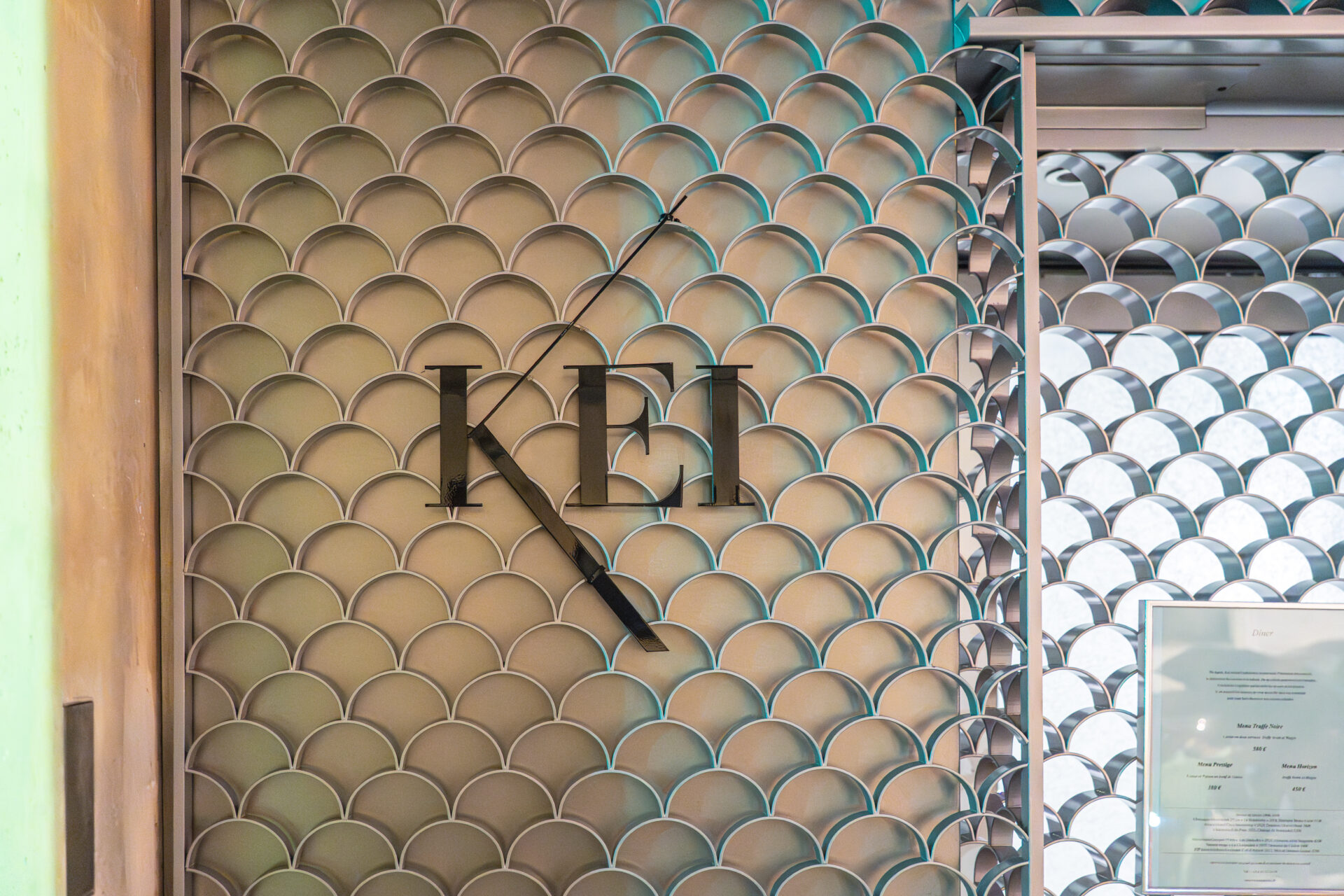

Dining Room
Beyond the entrance lies a space where refinement and tranquility coexist. The interior, grounded in tones of white and grey, is strikingly minimal—free from unnecessary ornamentation.
Fresh flowers placed at each table and the quiet presence of the ceramics blend harmoniously into the setting, each element contributing to the room’s composed atmosphere.
With seating for around 30 guests, the space feels both intimate and intentional. The service is meticulously quiet, allowing guests to immerse themselves fully in the experience. It evokes the sensation of observing art in a museum—each dish presented like a canvas.
Abstract paintings adorn the walls, and every shadow and glimmer of light feels curated. In this room, the boundaries between food, space, and silence gently dissolve.
Here, dining is not conversation—it is dialogue. That feeling, subtle yet lasting, lingers well beyond the final course.
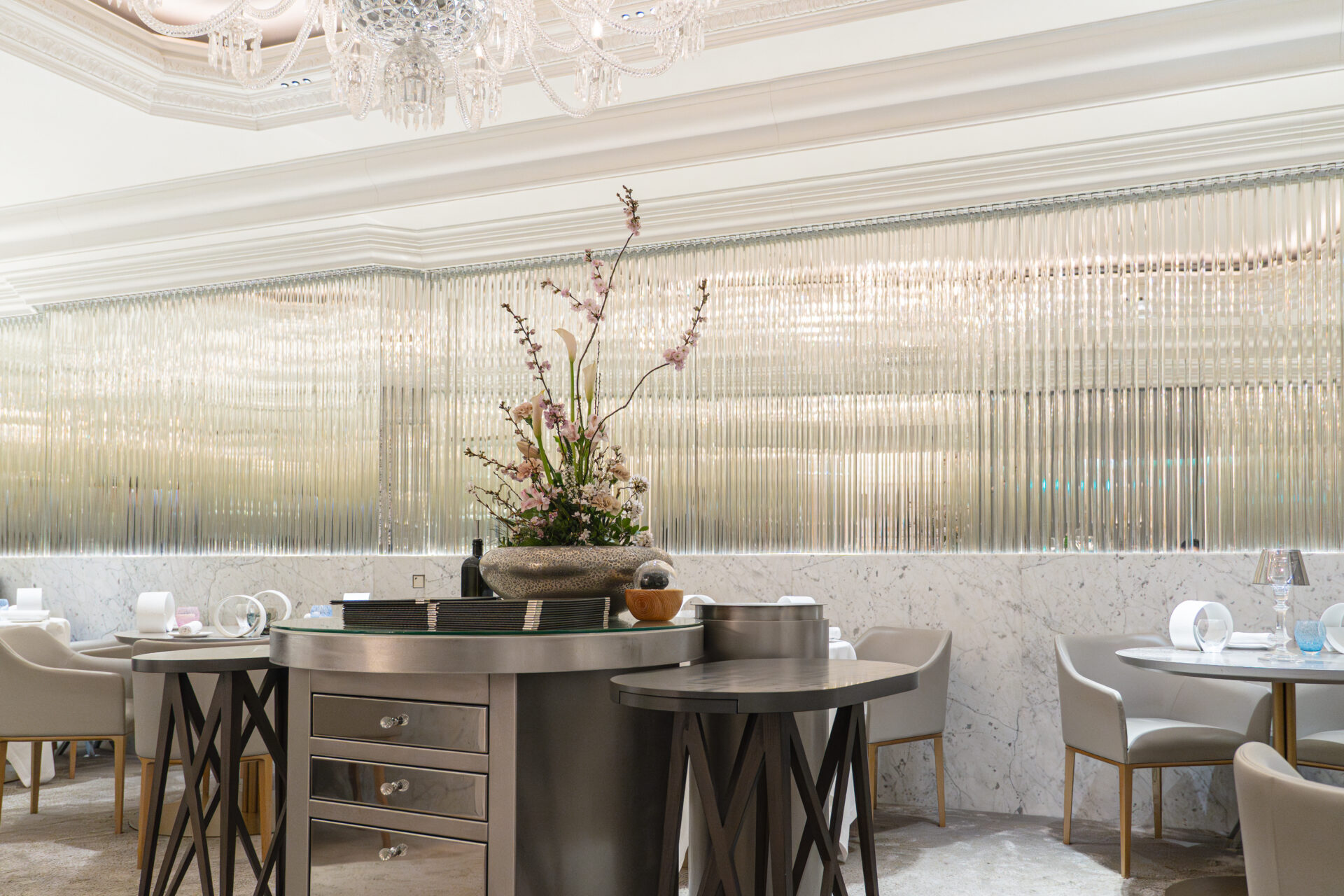
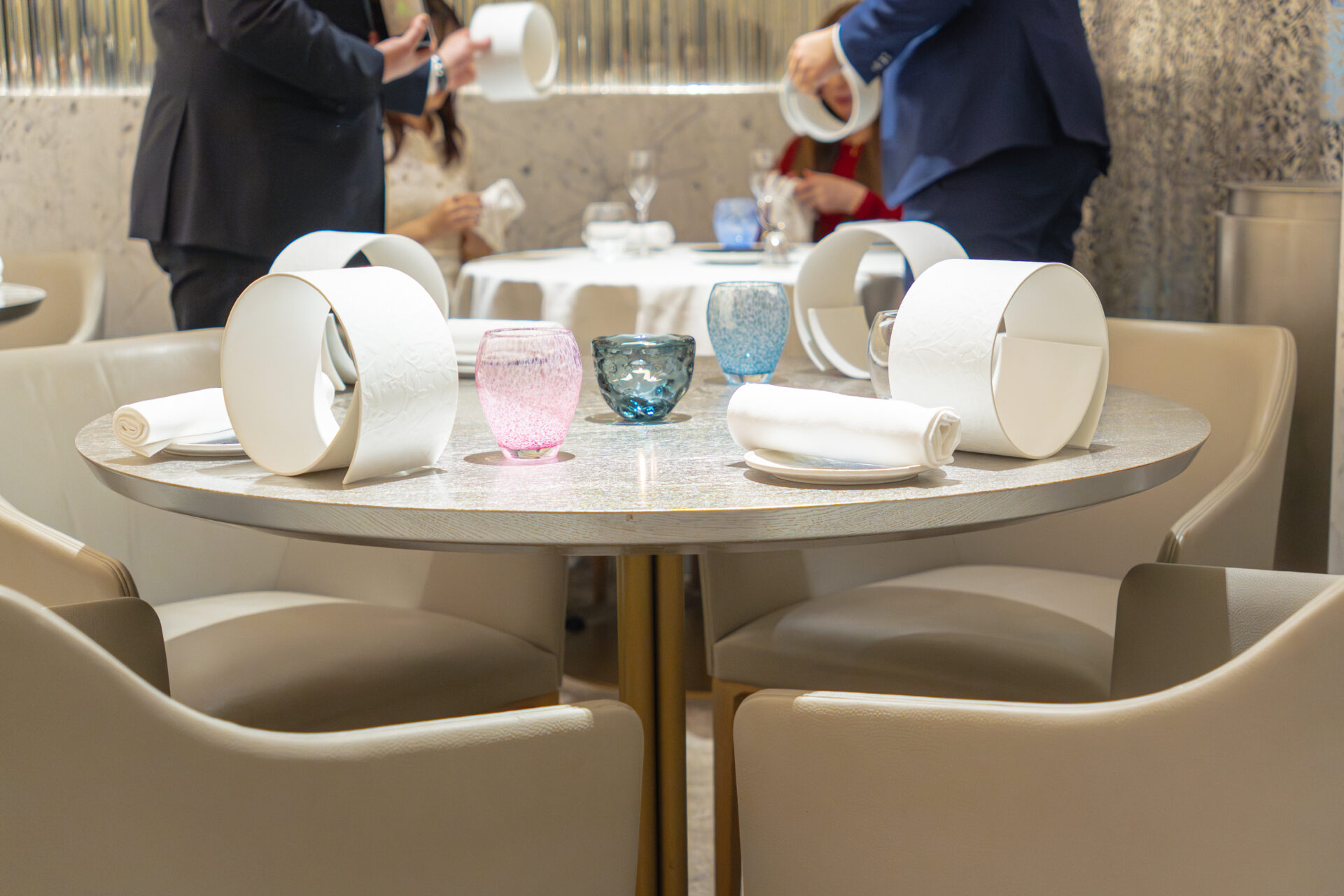
Menu Presentation
Dinner at Restaurant KEI follows a classic tasting menu format, but with a unique twist. The restaurant offers three different courses, each centered around a distinct main dish. Guests may choose according to their preferences, each course presenting a different expression of KEI’s world.
For this first visit, the pigeon-centered course was selected—a standard offering said to embody KEI’s culinary philosophy and structural beauty. While the wagyu and truffle options were tempting, this was a moment to appreciate the balance of ingredients, composition, and space—the essence of KEI.
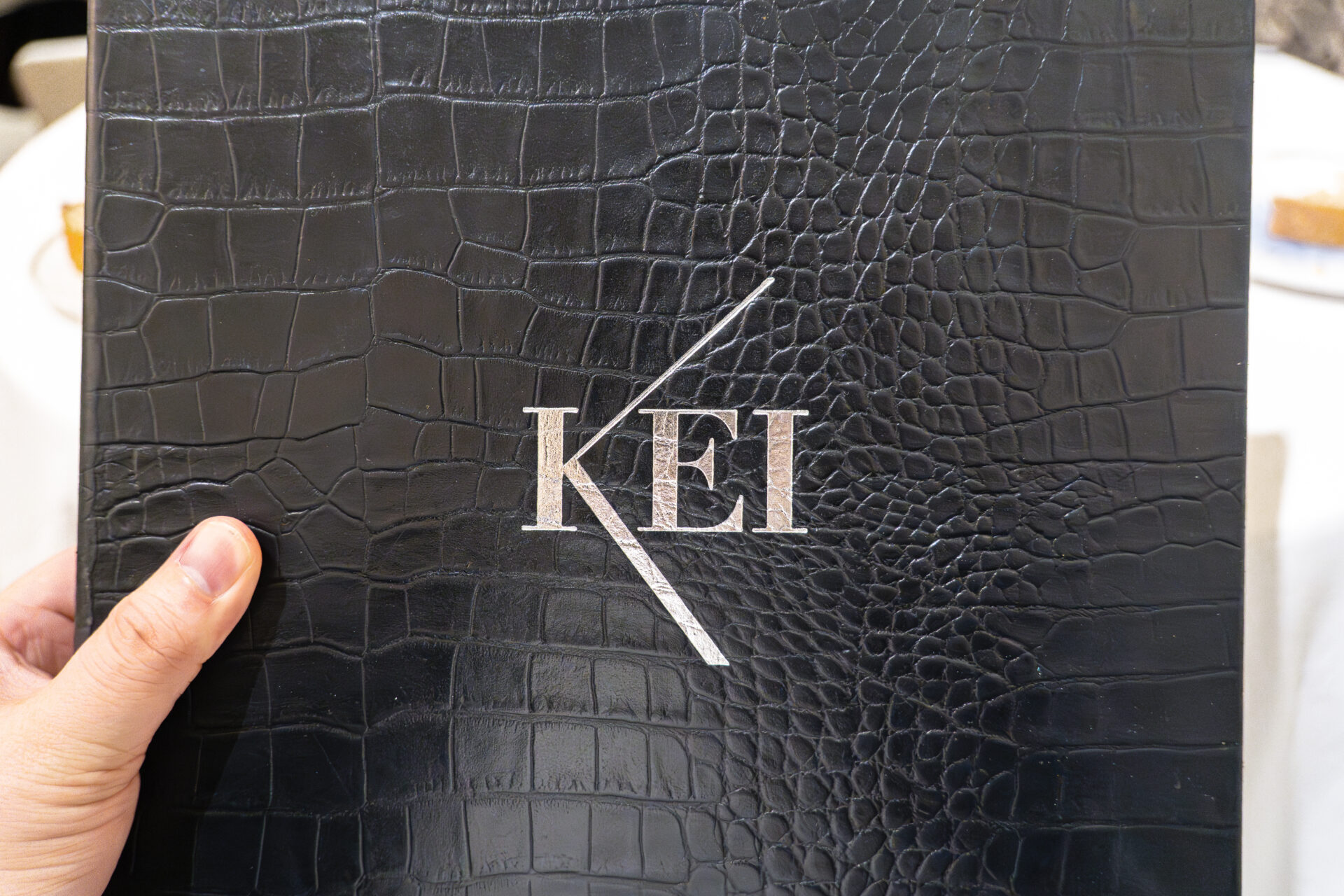
Starter Drink
The champagne ordered as a starter drink was Alfred Gratien BLANC DE BLANCS 2017.


The Dishes Tasted
Red Shiso Granité
The dish that marked the beginning of dinner was a granité of red shiso. This small amuse, served in a spoon, had an impressive deep crimson color.
The moment it entered the mouth, the refreshing acidity and gentle sweetness unique to red shiso spread out, and a crisp sensation awakened the palate.
Its pure and refreshing start served as an extremely delicate and precise introduction to the upcoming courses.
This granité also appeared in the film “Grand Maison Paris” and has also been served in the course at KEI in Tokyo as a kind of signature.
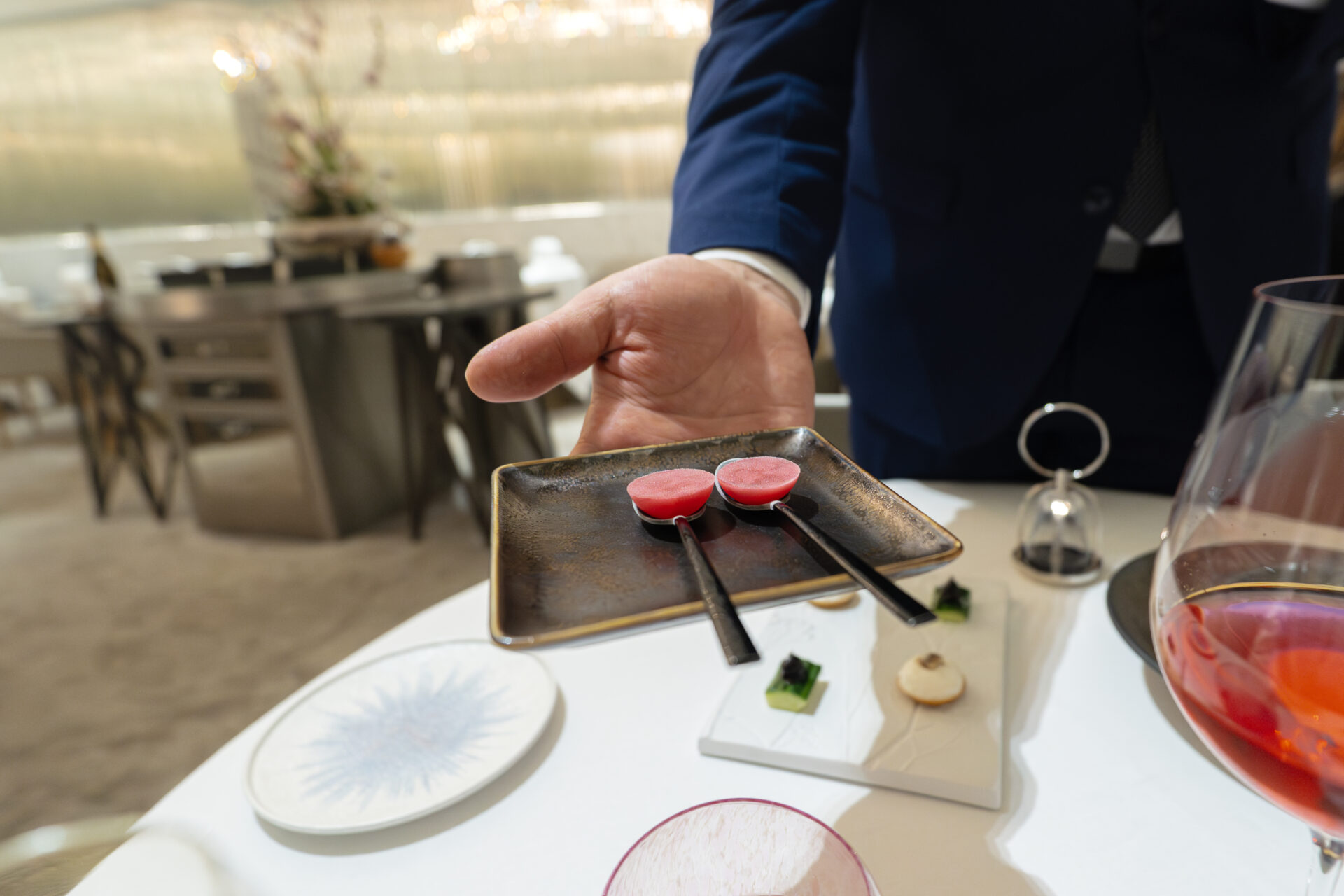
Parmesan Cheese Gougère
The second amuse was a delicate cheese tuile and gougère. The tuile was baked thin, with a light texture and a faint roasted aroma.
A pale red powder was sprinkled in the center of the tuile, adding depth to the fragrance with a chili-like spice, and beneath it was the gougère—crisp on the outside and filled with cheese on the inside.
The contrast between the tuile’s firm texture and the gougère’s soft expansion was pleasant, making it a dish full of playfulness and structure, well-suited for the early stage of the course.
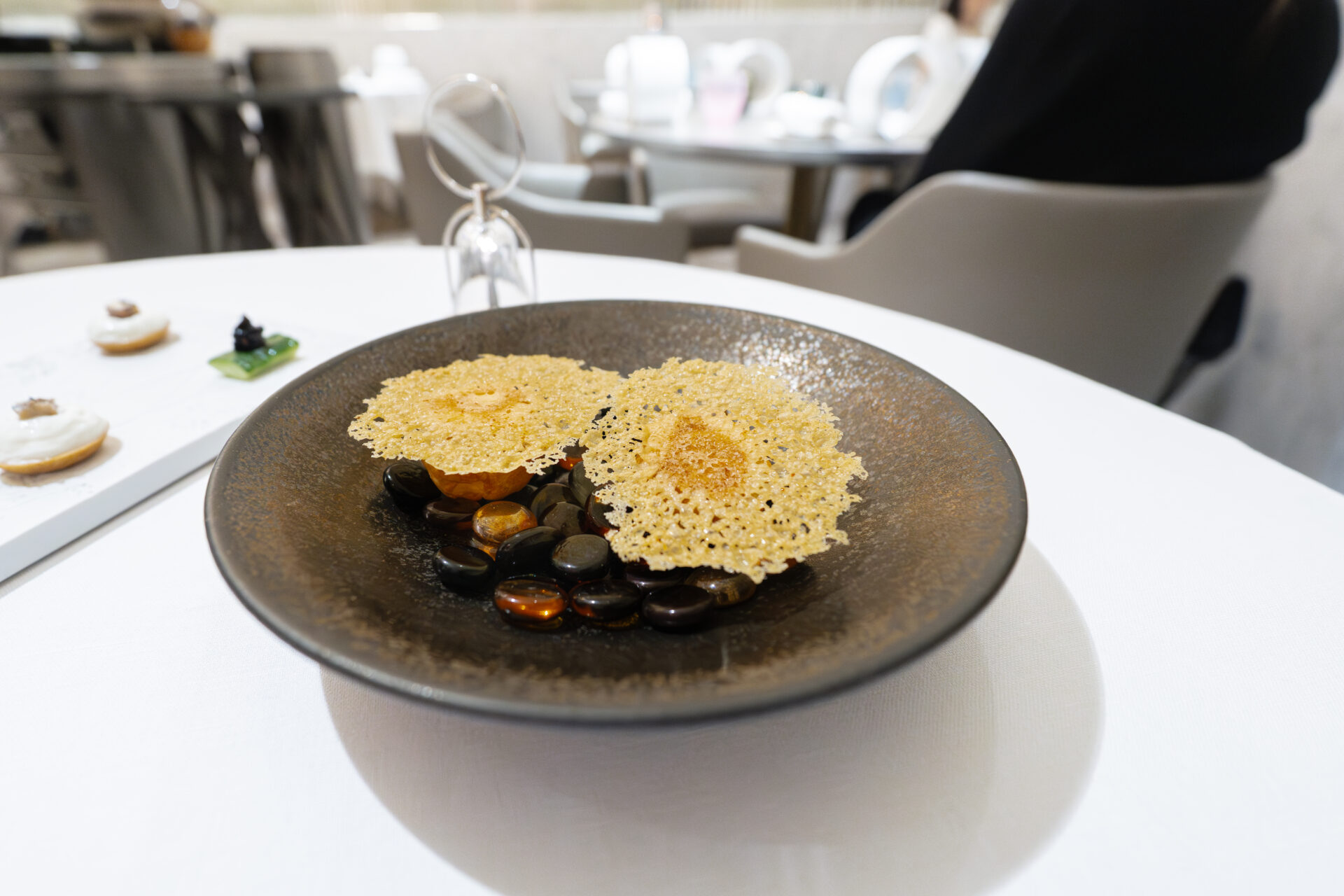
Black Miso and Cucumber, Sardine and Yogurt Mousse Tartlet
The final amuse consisted of two bite-sized appetizers quietly placed on a plate.
One was fresh cucumber topped with a paste of black miso. A familiar combination in Japanese cuisine, but here it was reconstructed into a refined rectangular form, and the elegant miso aroma evoked the sense of a “Japanese memory” in KEI’s style.
The other was a tartlet lightly covered with a yogurt-like mousse. At the center, a small piece of sardine added a salty accent.
When tasted, the crisp tart base was followed by the yogurt’s tartness and the fish’s umami, creating a delicate balance of salt, lactic acidity, and fragrance.
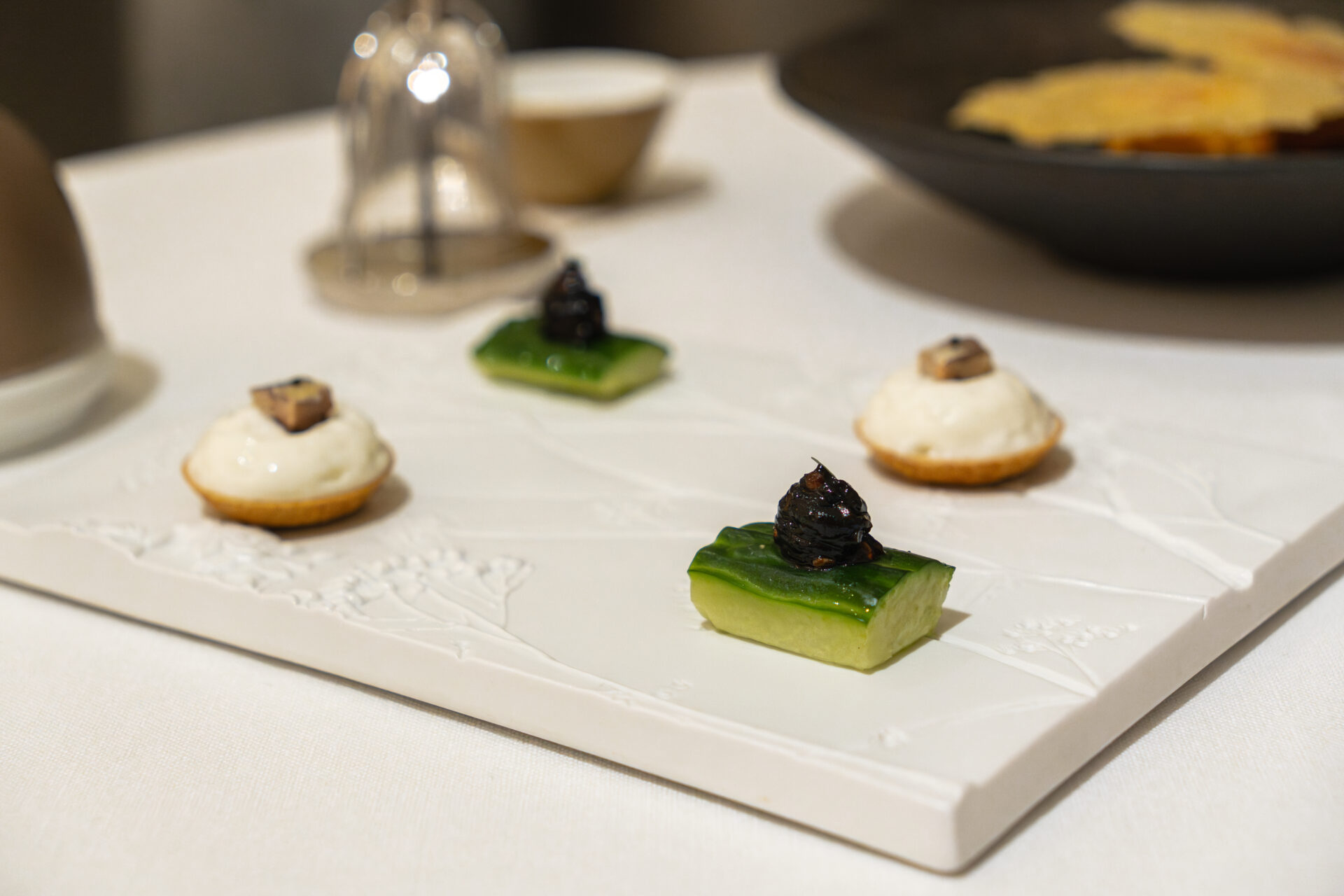

After the amuse-bouches, house-made bread, butter with the KEI stamp, and original extra virgin olive oil were served.
The bread was a semi-hard type kneaded with grains. The outside was toasty, while the inside was moist and dense. Even when eaten as is, or paired with butter or oil, the distinct character of each ingredient could be clearly tasted.
The butter bore a clean imprint of the word “KEI.” Amid the quiet of the plate, this signature quietly stood out.
Its texture was smooth and creamy, offering a restrained richness that was not overly milky, and its presence seemed to reflect KEI’s culinary philosophy.

Also notable was the restaurant’s original olive oil. Made using the Sicilian variety “Piricuddara” and specially bottled by Cedric Casanova, a popular olive oil brand in Paris, it had both gentle fruitiness and a green freshness, leaving a refined, vanishing finish in the mouth.
Rather than supporting the bread, these accompaniments felt like independent works that filled the “space” between dishes. Each component gently asserted its presence while connecting to the lingering flavor of the next plate.
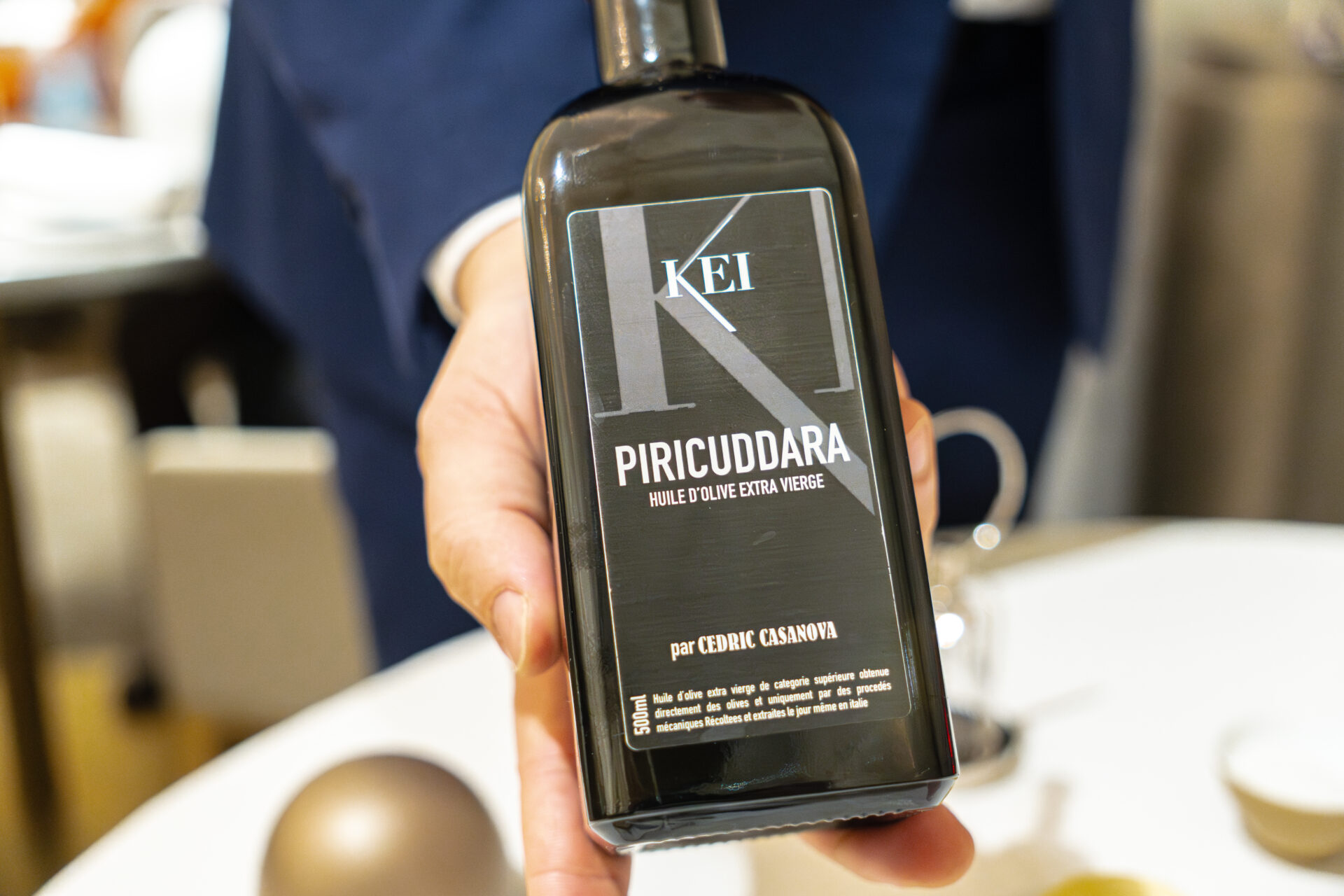
Oyster / Red Wine Vinegar
Placed quietly on a white dish layered with ice was a single oyster shell. Inside it was a dish reconstructed in KEI’s style.
The oyster was not served raw, but first carefully heated and then refreshed in seawater before being presented. This method allowed the mineral feel of raw oyster and the gentle umami brought by heat to coexist, resulting in a texture that loosened softly on the tongue.
Accompanying it was a sorbet of red wine vinegar and a jelly made of seawater. The sorbet was formed into a small sphere and placed in the center of the plate, allowing diners to gradually break and mix it, controlling the flavor as they go.
In the first half, one could enjoy the natural umami of the oyster, and in the second half, the accent of acidity introduced a dynamic shift. This dish served the role of a “prologue,” carefully designed to consider the balance of the entire course.
Delicately placed borage flowers and watercress added a refreshing touch, both visually and on the palate, offering a subtle sense of negative space.
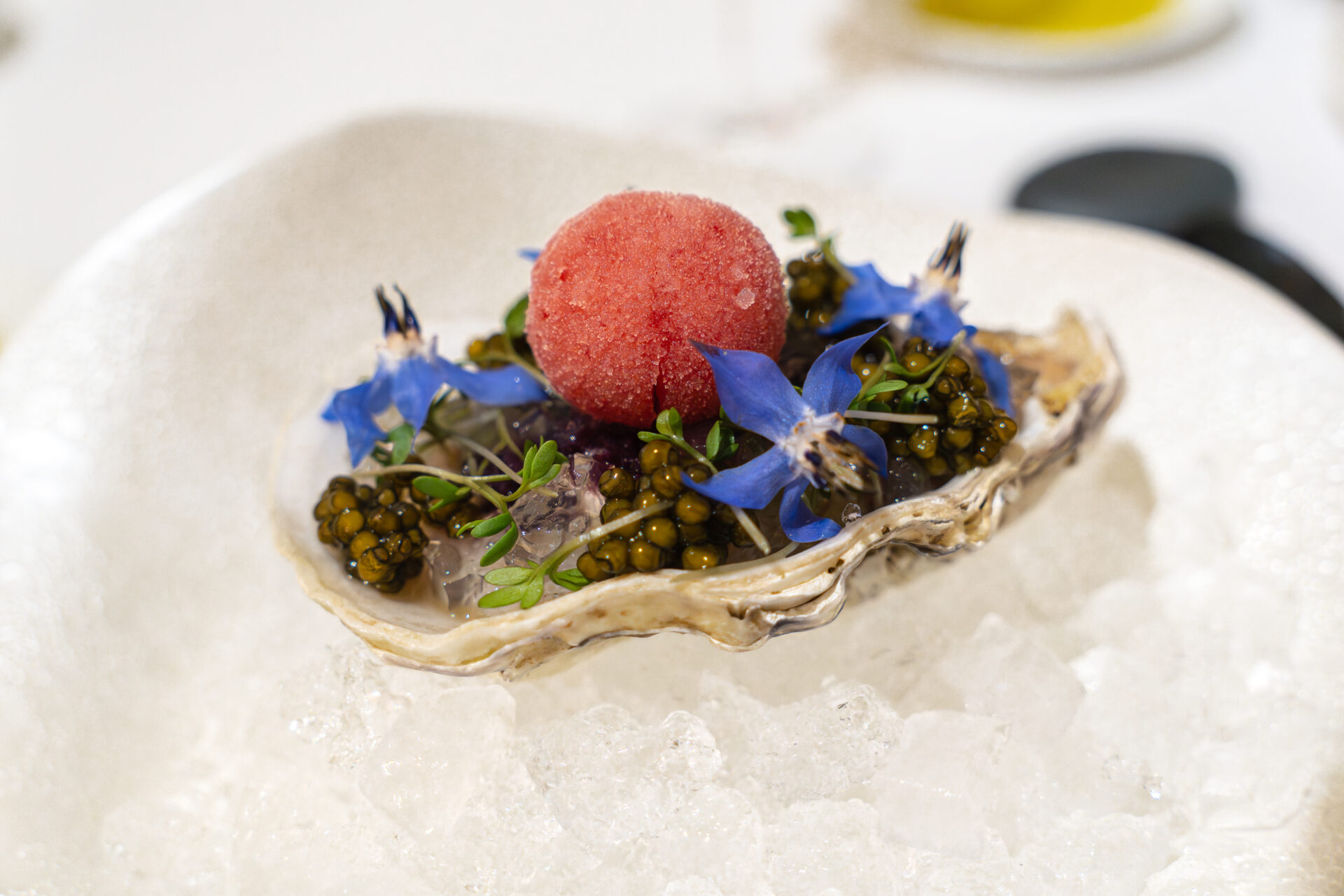
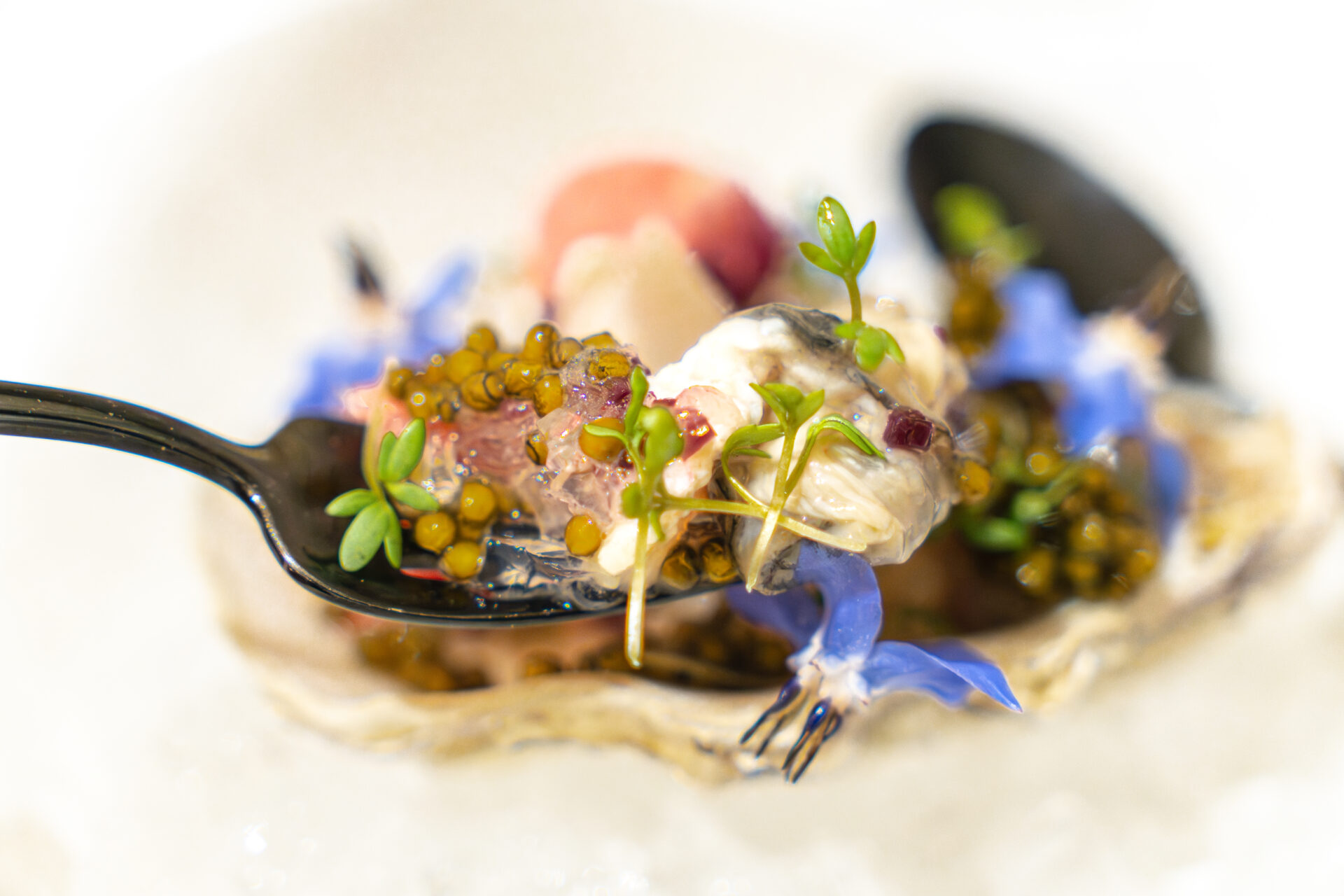
Garden Salad
A dish symbolic of KEI, the signature “Garden Salad.” It was a delicately structured and vibrantly alive composition, as if the scenery of a garden with blooming flowers had been transferred directly onto the plate.
Dozens of varieties of vegetables, herbs, and flower petals were assembled in a three-dimensional manner, and beneath them lay a gently foaming vegetable emulsion.
The aroma, texture, bitterness, acidity, even the sense of soil and water— each element quietly told its own story.
On the surface, crumbled croutons, nuts, and powdered flavorings were scattered, adding a light, layered dimensionality to the whole.
This dish transcended the category of “salad,” and showcased the precision of composition, structure, and taste.
The “Garden Salad” also appeared in the 2024 film “Grand Maison Paris.” It was portrayed as a dish created by the main character, Obana, and it reflected KEI’s respect for nature, dialogue with ingredients, and architectural beauty in the cinematic world as well.
Each bite changed the scenery, layering new memories. Rather than being “tasted,” this salad was “walked through.” It gently narrated the very philosophy of KEI.
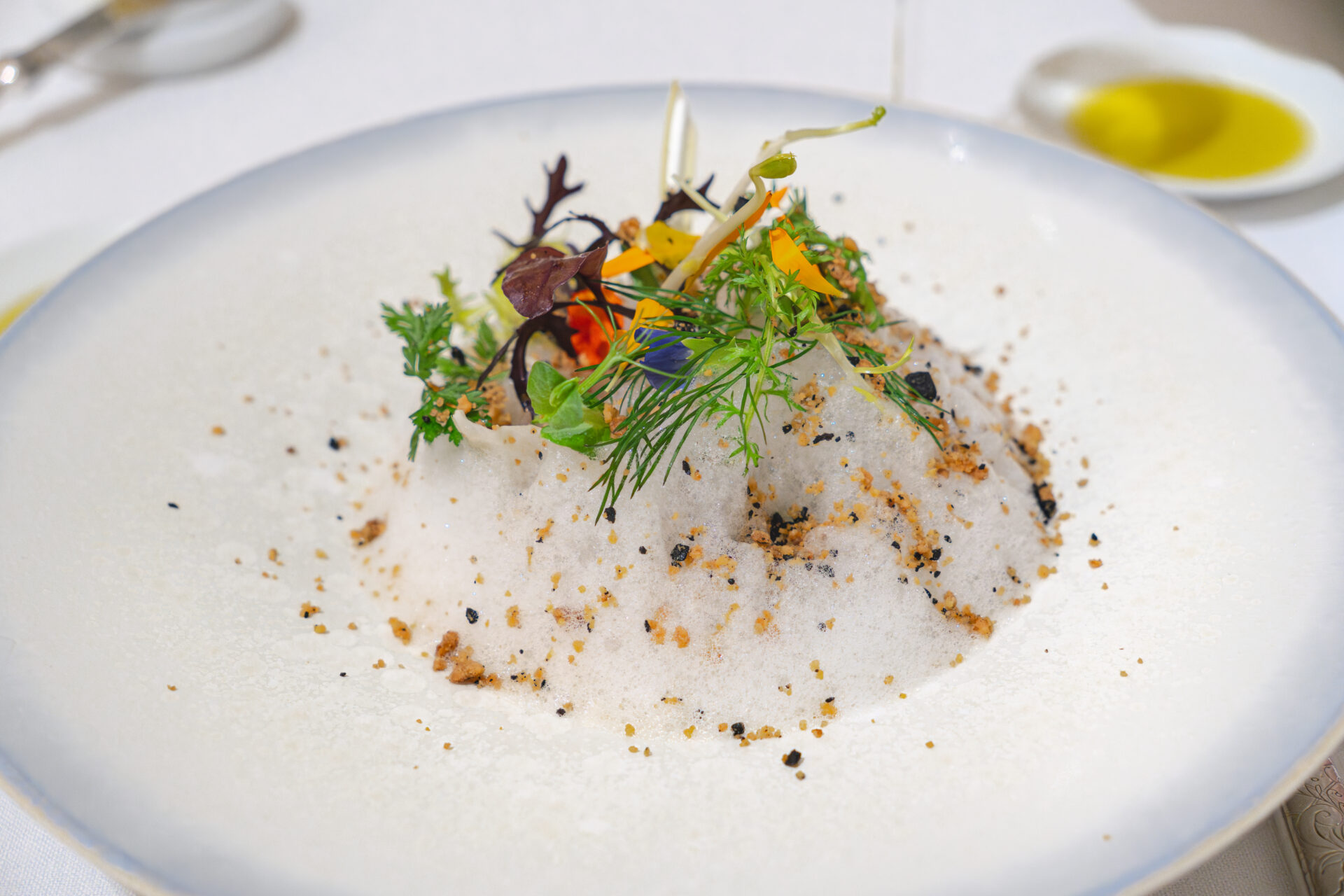
──Meursault “Le Limozin” 2019 / Domaine Buisson Battault
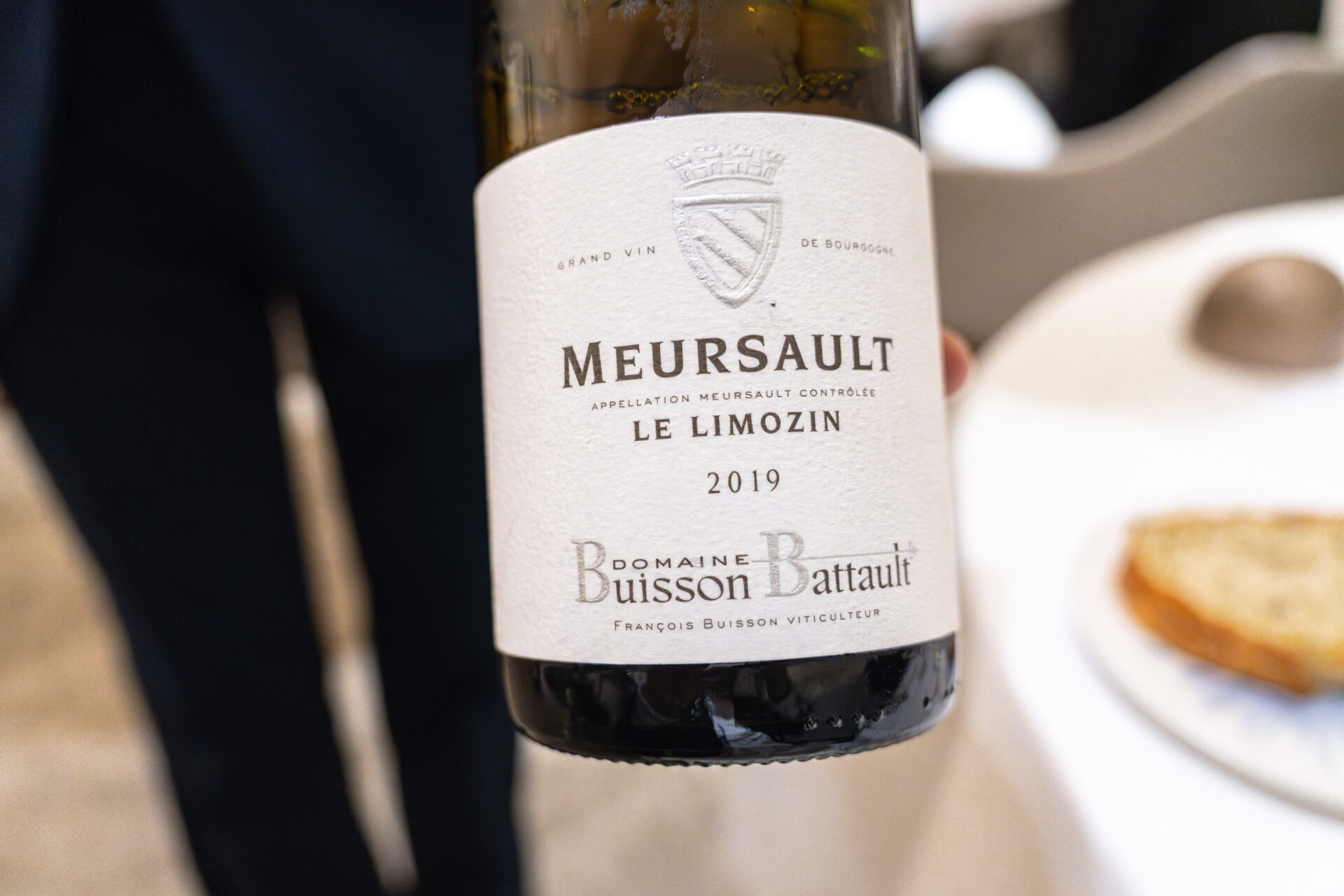
Sea Bass with Crispy Scales
The fish dish presented was sea bass cooked with its scales crisped. The surface was raised like an artwork with the scales standing up, making it almost a shame to cut into.
Although it followed the classic French technique, the final finish was surprisingly light.
Beneath the crispy, aromatic skin was the tender flesh of the sea bass, cooked gently so that the fibers loosened as one cut in, releasing umami and oceanic mineral notes with every bite.
On top were finger lime pearls (also called lemon caviar), adding a popping citrus acidity that bounced on the palate and highlighted the sweetness of the fish.
On the side, a garnish combining anchovies, tuna, tomatoes, peppers, and mushrooms provided depth from earthiness and fermentation, with a brilliant balance of umami and acidity.
Each bite intertwined fish, sauce, and garnish into a cohesive whole.
With precise technique and layers of flavor, this dish embodied KEI’s signature “constructed beauty” in a seafood course.

Smoked Langoustine
Before the main dish, a langoustine from Scotland was served. It had been lightly smoked together with hay, infusing not only the shell with its roasted aroma but also the meat with earthy nuances, adding layers of fragrance.
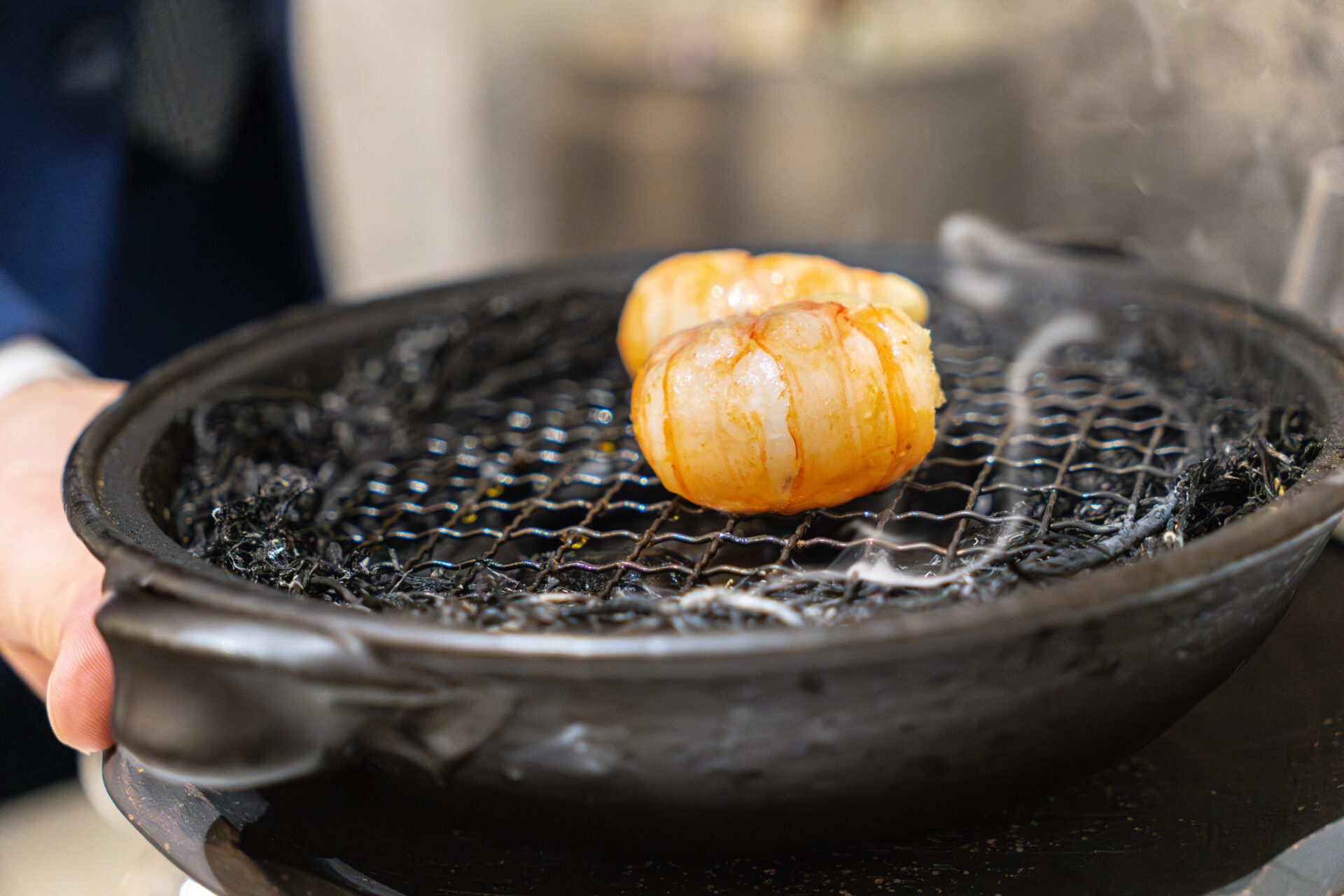
Beneath it was a warm base with a Chinese-inspired flavor made from chopped mushrooms and herbs, topped with a sauce made from Homardine (lobster-based reduction).
The langoustine was cooked to perfection, and the moment it was bitten into, its sweetness gently unfolded.
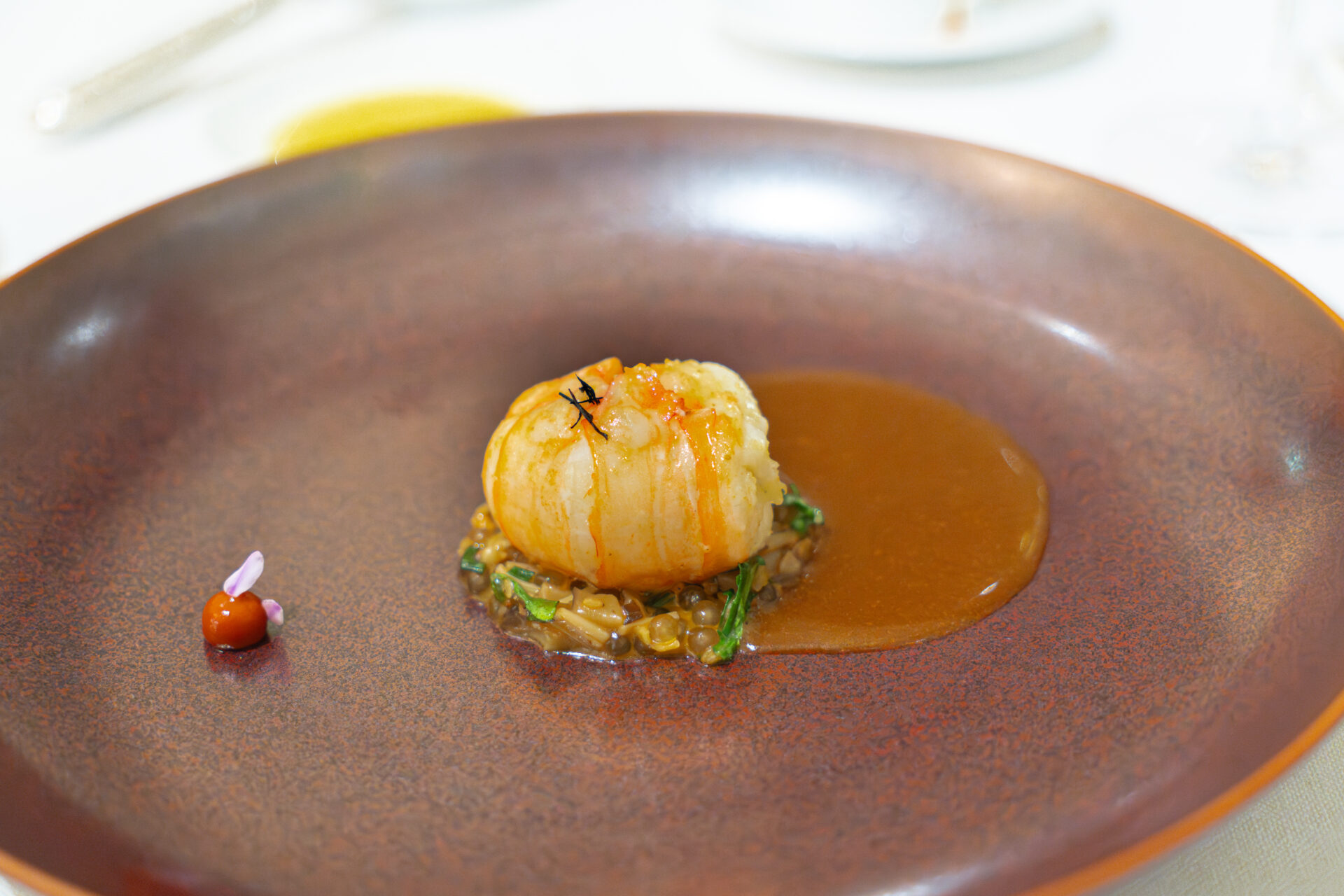
Gevrey-Chambertin Premier Cru “Lavaut Saint-Jacques” / Domaine Tortochot

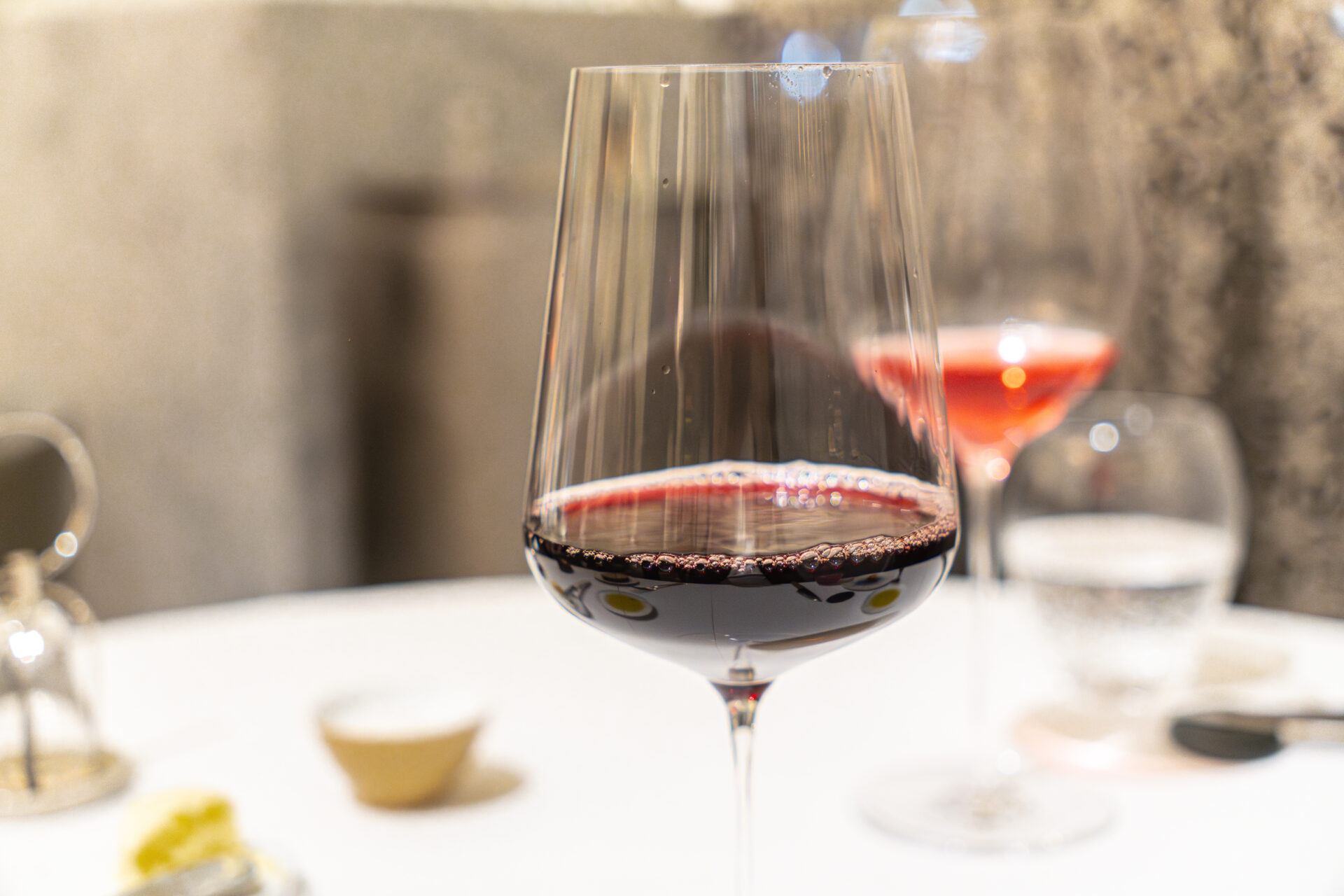
Roasted Pigeon
The main dish was roasted pigeon. The skin had a glossy finish, and when cut into, the center revealed a beautiful medium-rare doneness with a hint of red.
The cross-section reflected perfect temperature, timing, and technique—a textbook example of medium-rare.
Crushed nuts were scattered on top, adding a textural layer, while the sauce, a rich red wine reduction based on pigeon jus, brought depth and shadow to the iron-rich meat.
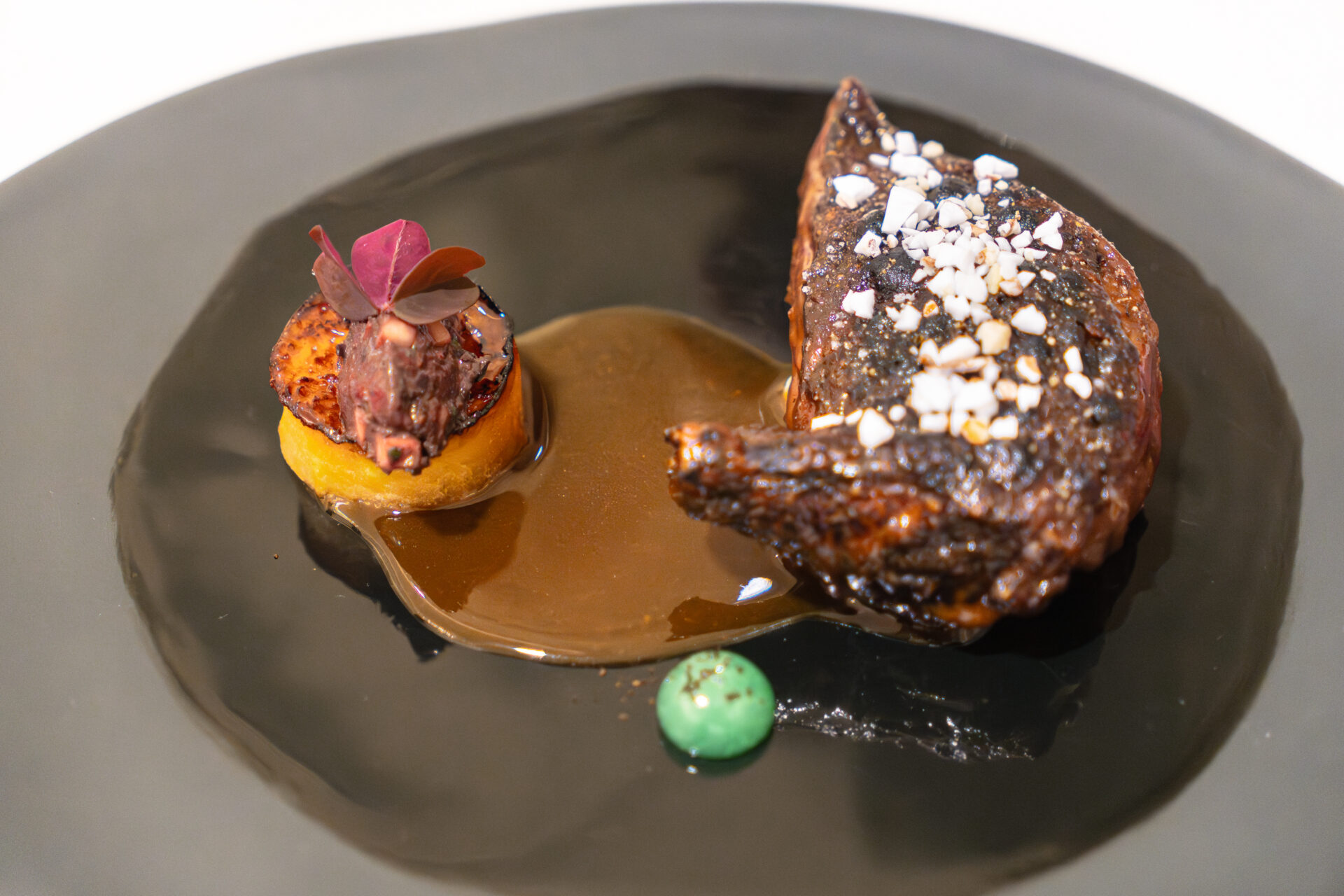

Dessert & Finale
Ginger Lotte, Lemon and Honey Palate Cleanser
As the lingering flavor of the pigeon dish remained,
a pre-dessert was served featuring ginger lotte with lemon and honey.
A small bite-sized plate that quietly reset the palate and calmed the senses.
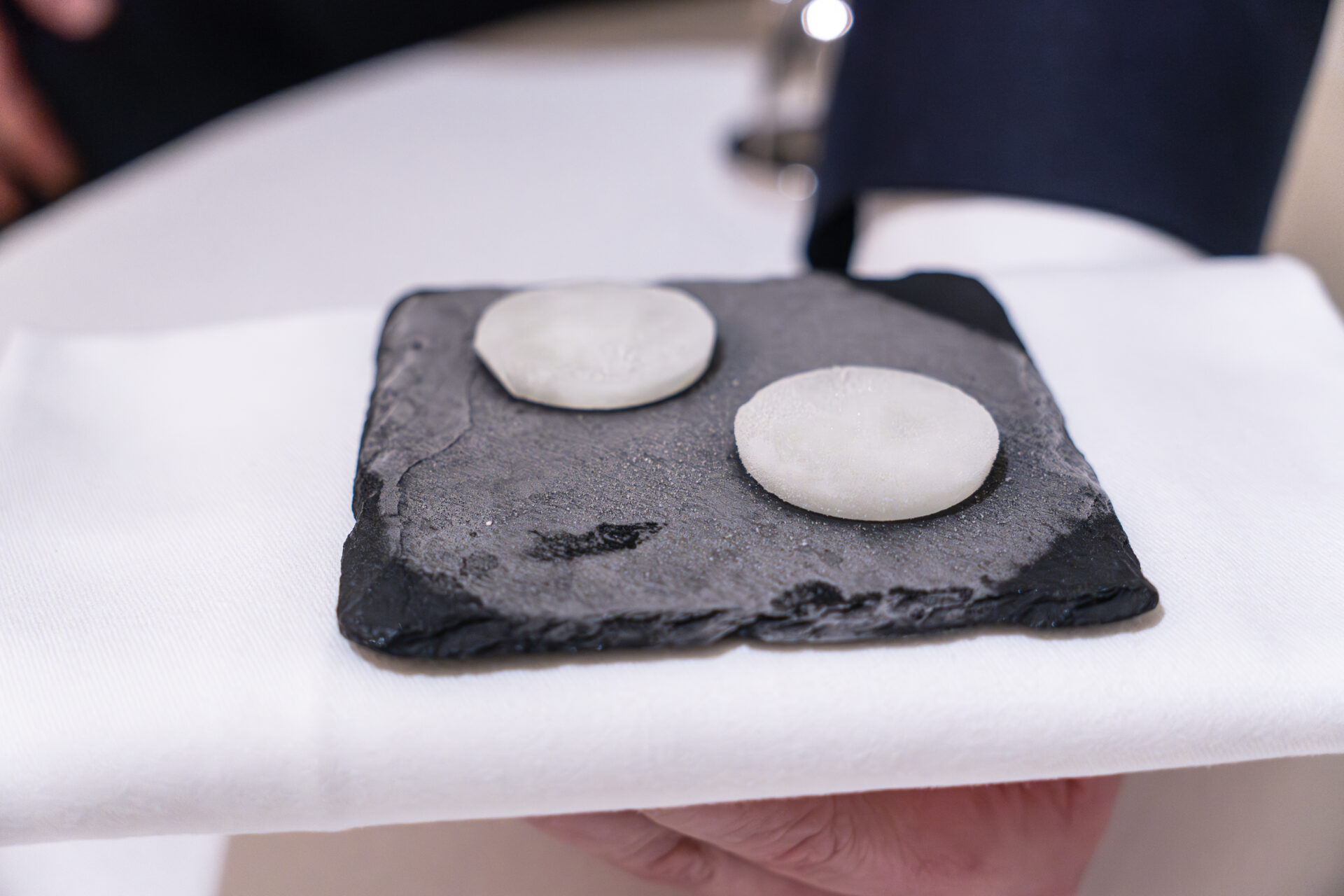
Blue Cheese Mousse
Smooth on the tongue, the mousse delivered the distinctive richness and saltiness of blue cheese,
which was then softened by the mellow sweetness of honey.
Topped with hazelnuts and pecans that added aromatic and textural contrast,
and a subtle hint of whiskey provided depth to the entire dish.
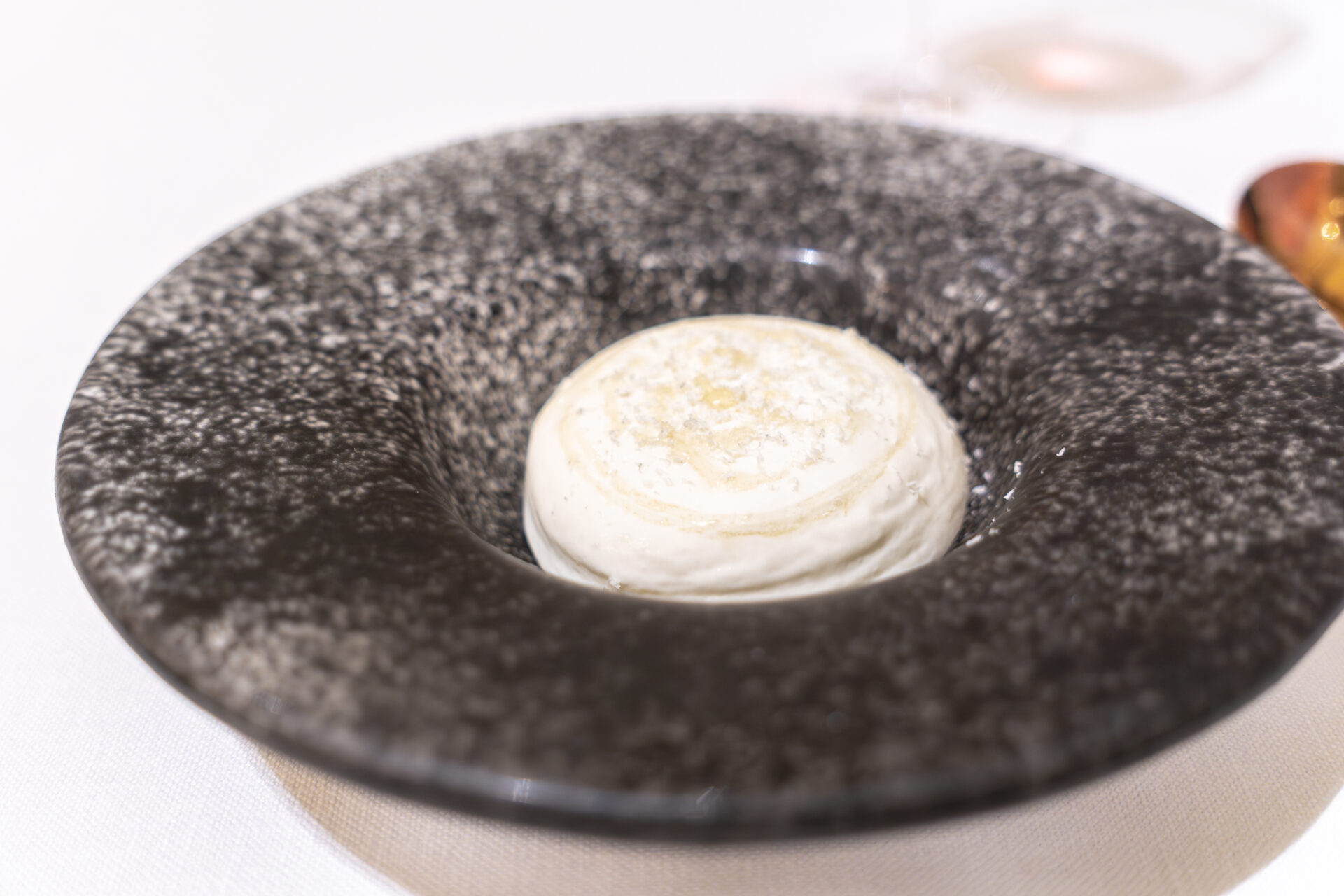
Citrus Vacherin with Spicy Jasmine Sauce
For dessert, KEI’s signature citrus vacherin was served.
Its flower-like, sculptural form was visually captivating,
underpinned by intricately composed flavors and structure.
At the base was a chilled parfait of blood orange.
It delivered a beautiful harmony of sweetness, bitterness, and acidity typical of citrus.
Above that was a light sorbet of yuzu, whose fragrance rose through the chill.
Finishing the dish was a surprising spicy jasmine sauce.
While fragrant and elegant, the background held a gentle heat from chili spices,
creating tension even in the final spoonful.
Though a dessert, the composition stood as a complete dish,
with KEI’s culinary philosophy quietly breathing beneath its beauty.
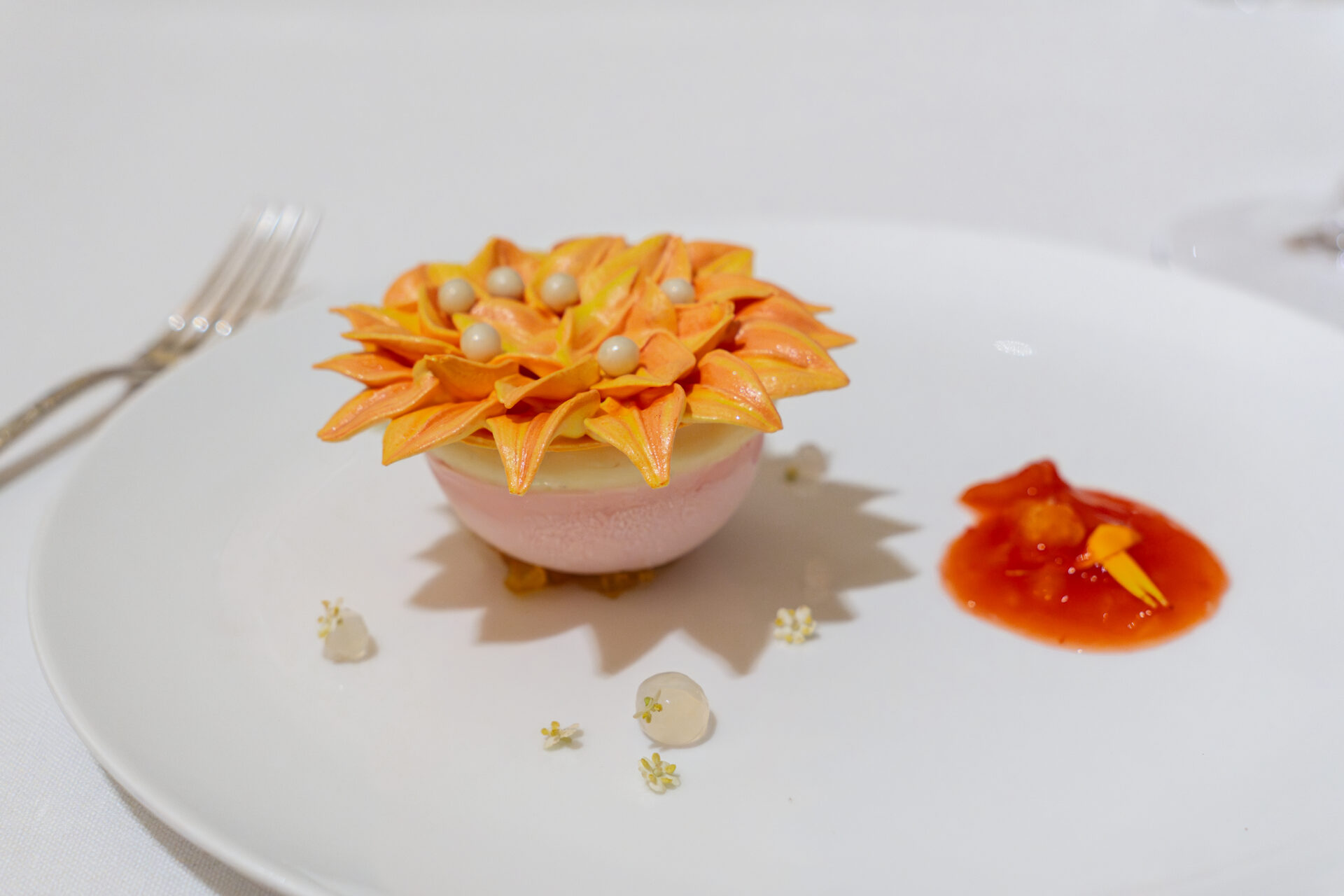
Mignardises
To conclude the meal and close the lingering impressions,
two small confections were presented.
The first was a soft, round piña colada ball.
Within the gentle sweetness of coconut, the bright aroma of pineapple bloomed,
melting softly across the palate with a relaxed, resort-like feel.
Yet its composition remained delicate and distinctly KEI.
The second was a glossy chocolate tart filled with caramel.
The crisp tart shell held a rich caramel that slowly melted,
harmonizing with the chocolate’s bitterness.
The balance of sweetness, bitterness, and richness was carefully designed within a single bite—
evident from the very first taste.
Neither was flashy; both were a quiet finale prepared to gently close the course.
They reaffirmed how KEI’s cuisine remains “flawless and beautiful” to the very end.
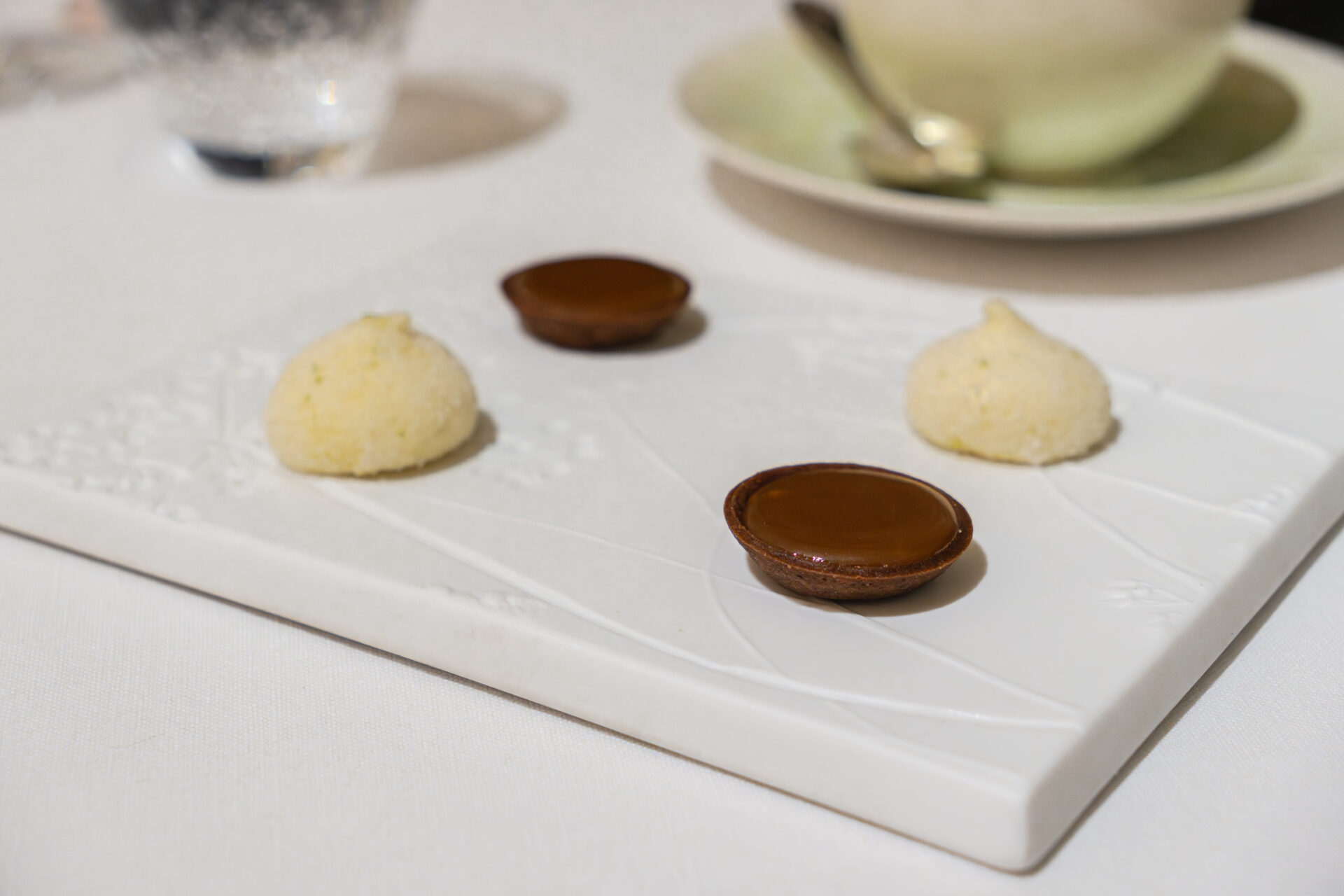
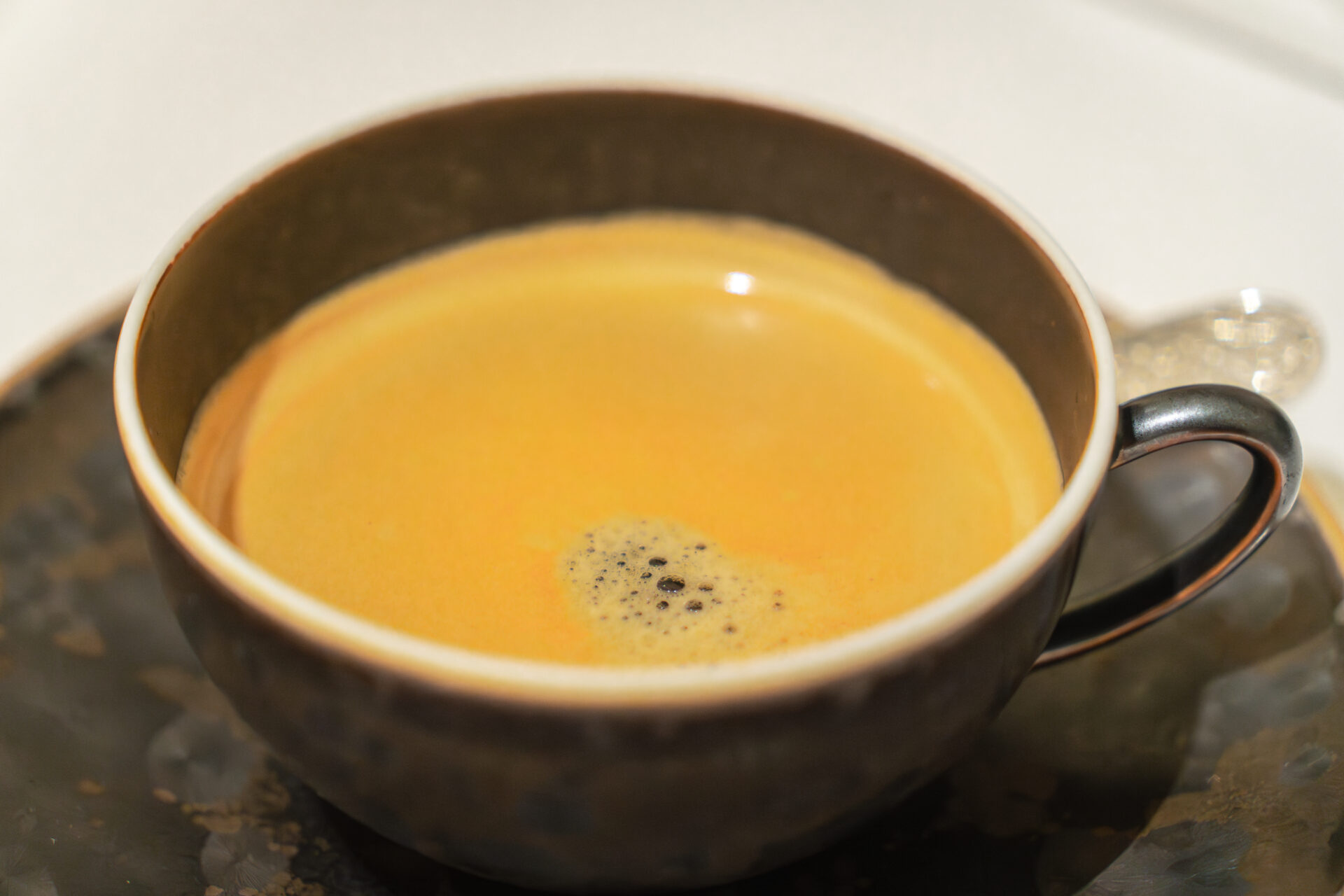
As the quiet lingering taste of the mignardises remained,
I was handed a parting gift: a house-made salted butter caramel.
That small piece, in which the richness of the butter and the accent of salt melded perfectly,
seemed to encapsulate the continuing time of KEI even after the meal had ended.
And finally, Chef Kei Kobayashi emerged from the kitchen for a commemorative photo.
His modest smile and calm gaze exuded the quiet strength that sustains this space
and a deep respect for cuisine.
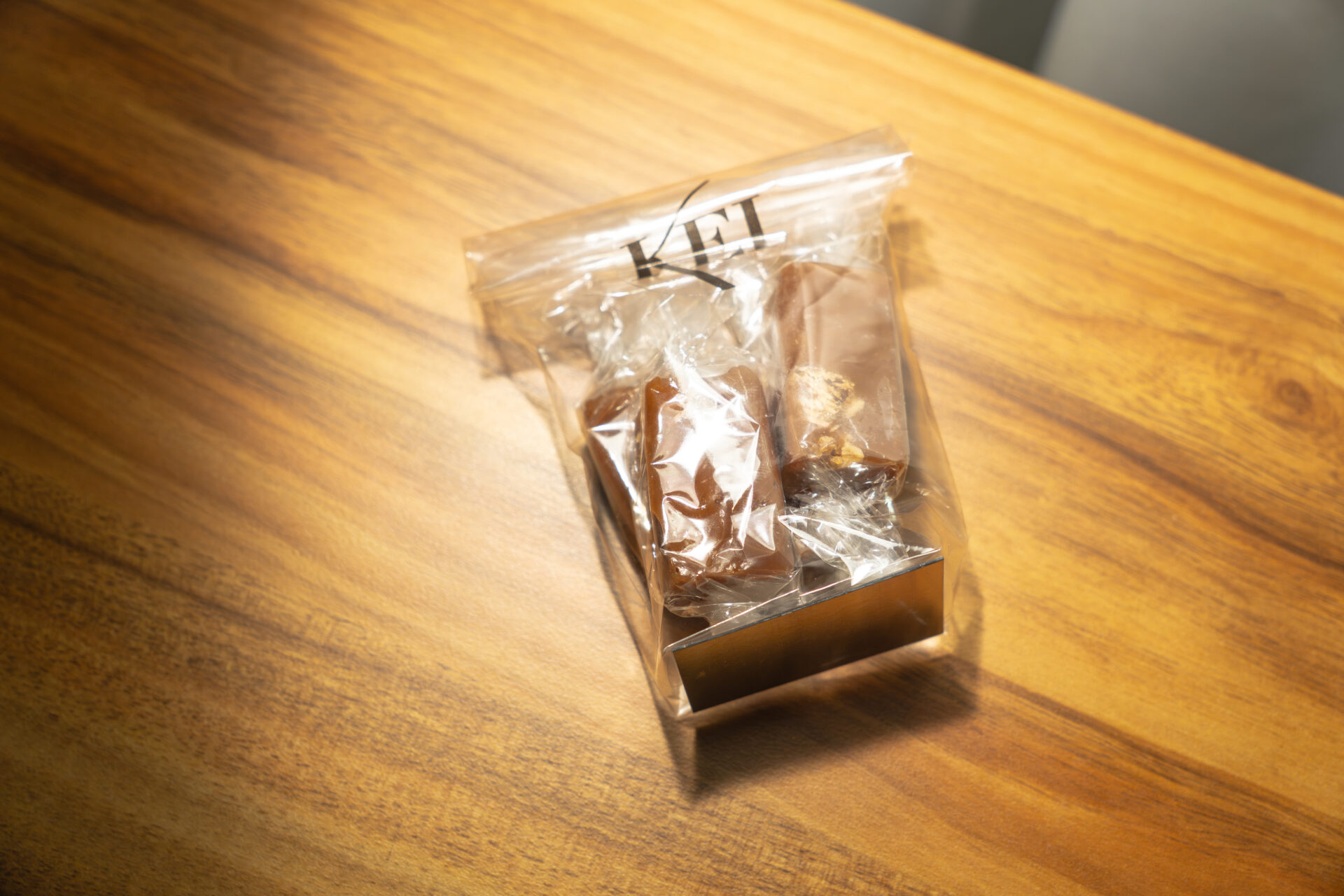
Reflections and Impressions
Amid lingering excitement from the film “Grand Maison Paris,”
my long-awaited first visit to Restaurant KEI finally came true.
With the vivid images of the food and space from the film still in mind,
it was now time to experience that world with all five senses.
KEI’s cuisine avoids flamboyant presentation or excessive explanation.
Yet each dish is carefully constructed with clear intent—
from doneness and aroma to acidity and negative space.
Rather than adding flavors, it draws depth and tension by subtraction.
In its quietude, a definitive silhouette emerged.
From the Garden Salad to the miso-marinated pigeon,
and the citrus vacherin interwoven with spice—
every dish pursued the harmony of structure and taste.
“Not to maintain the star, but to earn it again each year.”
True to that phrase, both the food and the space
conveyed a quiet resolve to never stop moving forward.
The dishes I encountered that day will likely return
to my memory, quietly, in some unexpected moment.
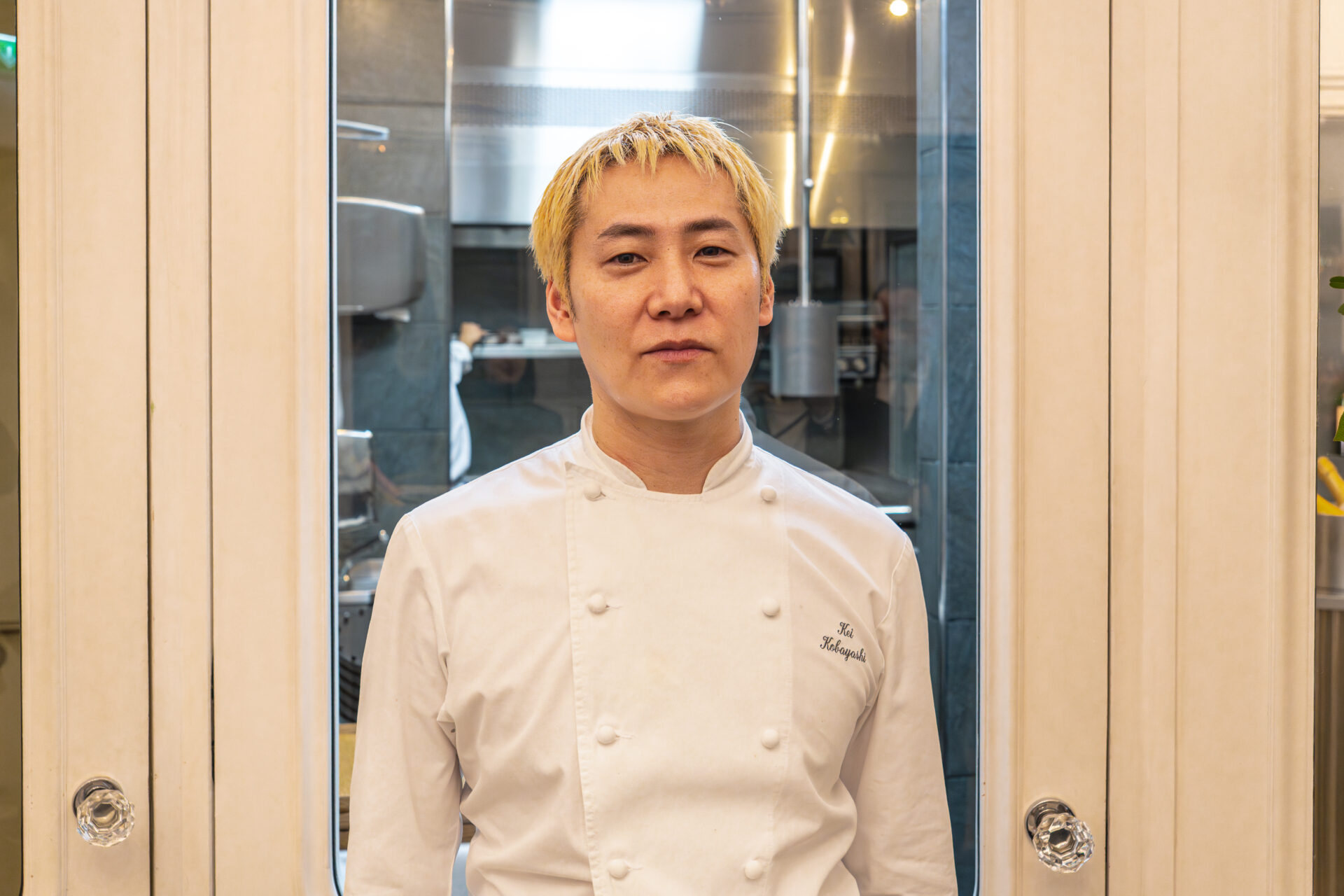
Reservations and Access
Reservations can be made via the official website. Phone inquiries are also accepted.
It’s best to book around two months in advance. If you have allergies or ingredient preferences,
it’s recommended to inform them at the time of reservation.
Phone: +33 (0)1 42 33 14 74Address: 5 Rue Coq Héron, 75001 Paris, FranceNearest station: Metro Line 1, “Palais Royal – Musée du Louvre”
Behind this culinary experience lies a journey.
This visit to the restaurant was a part of a larger trip titled “50 Best Gastronomic Journey.”
The full story of this journey through some of the world’s greatest food capitals is shared in the main travel logs.
→ Read the full travel chronicles here:
- TAGS

